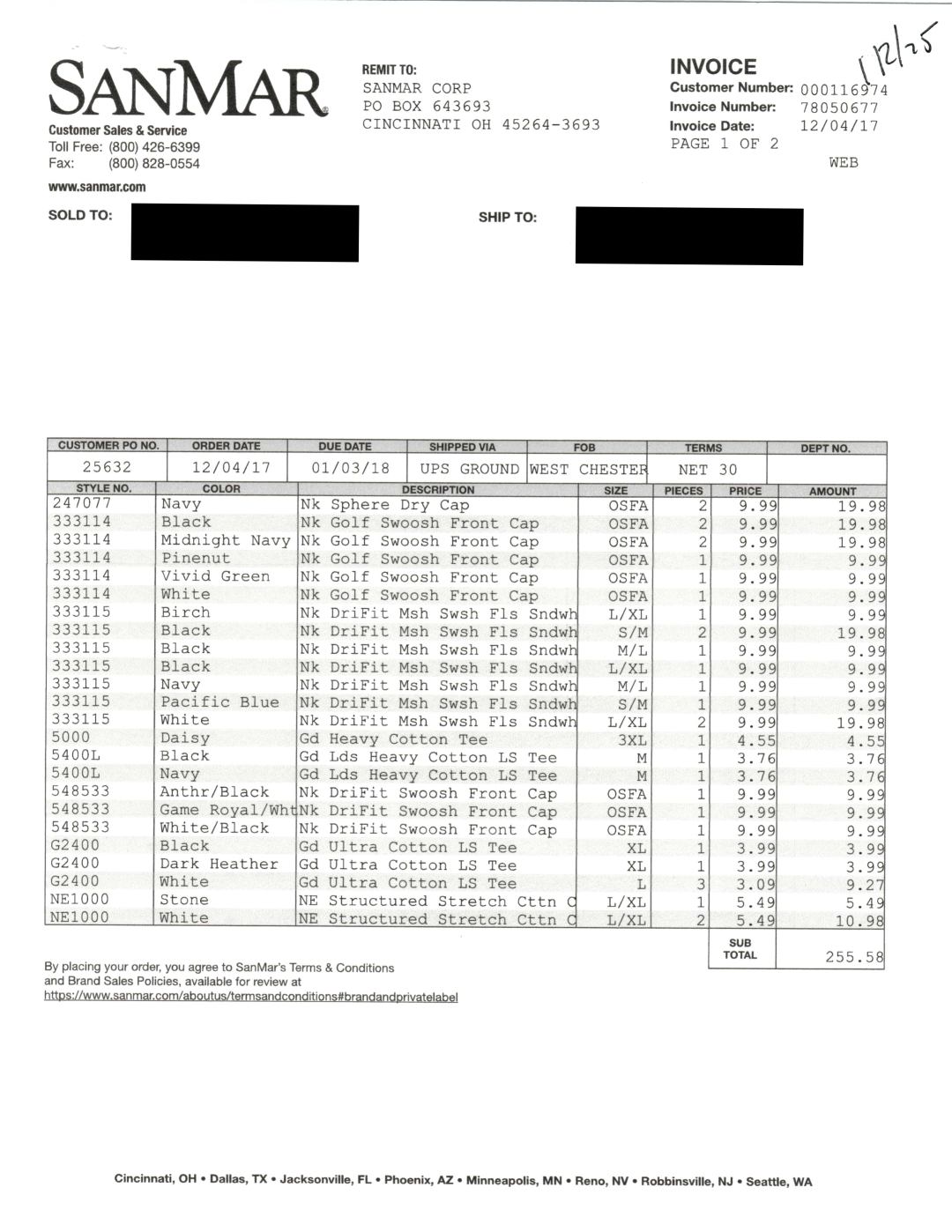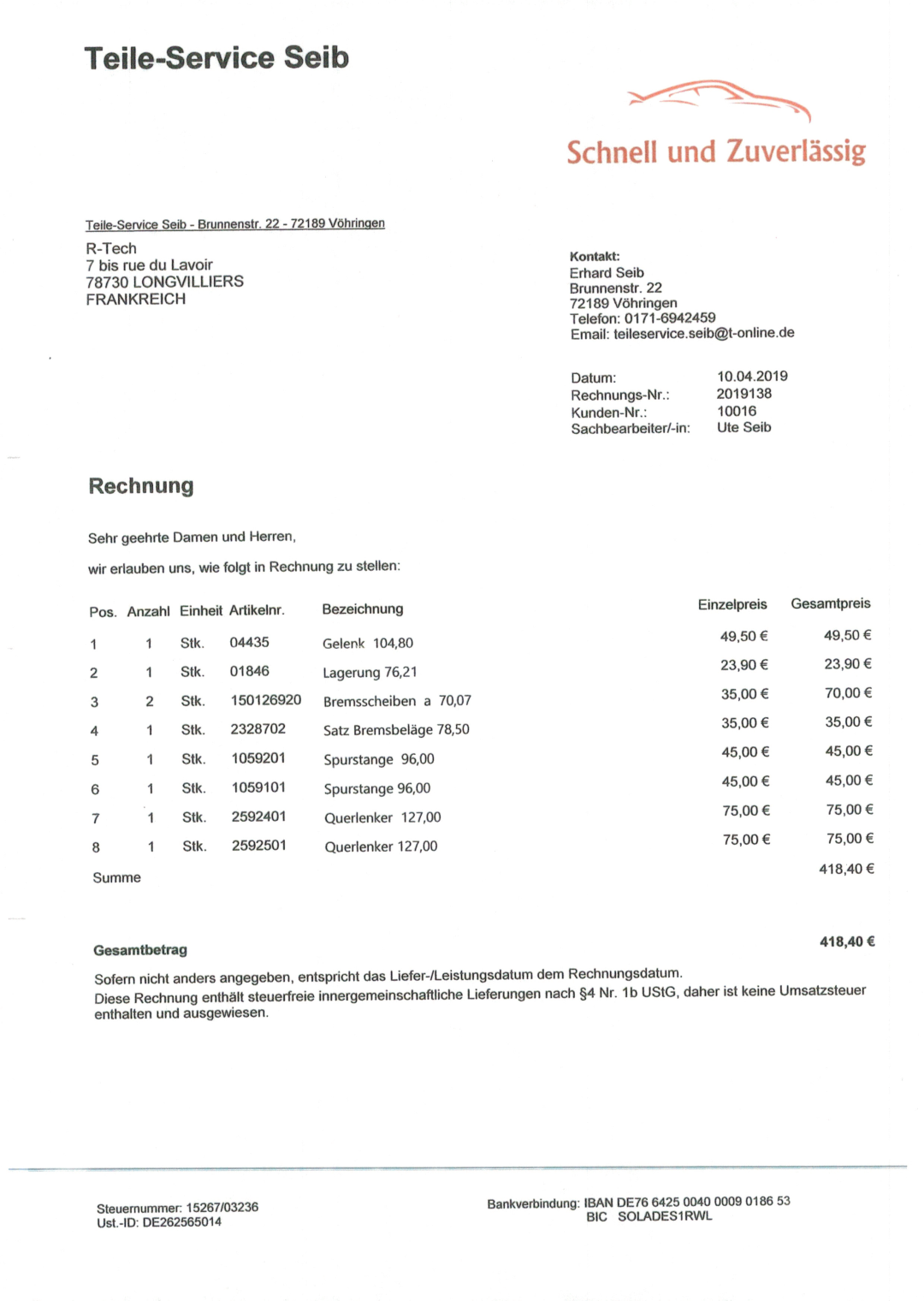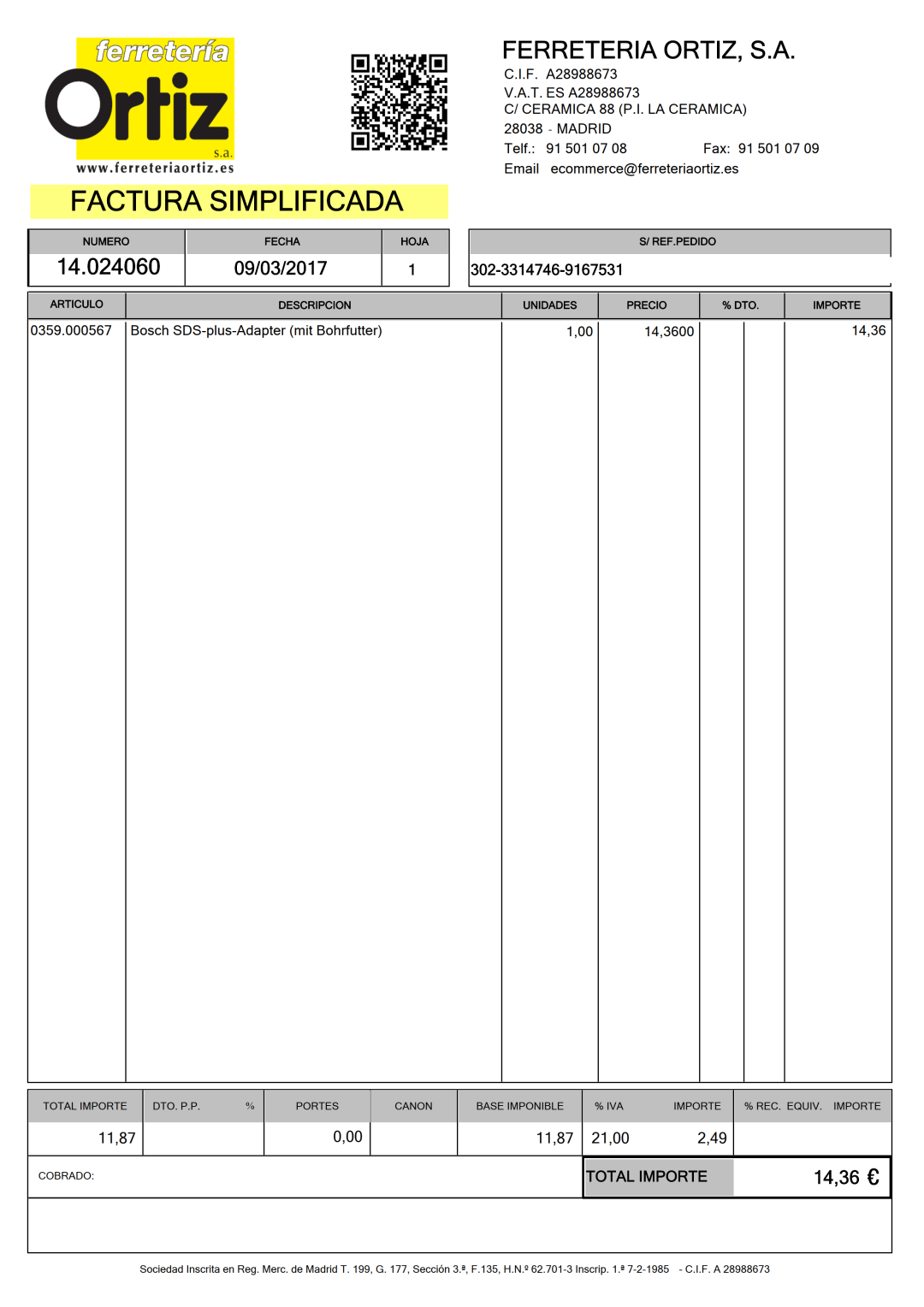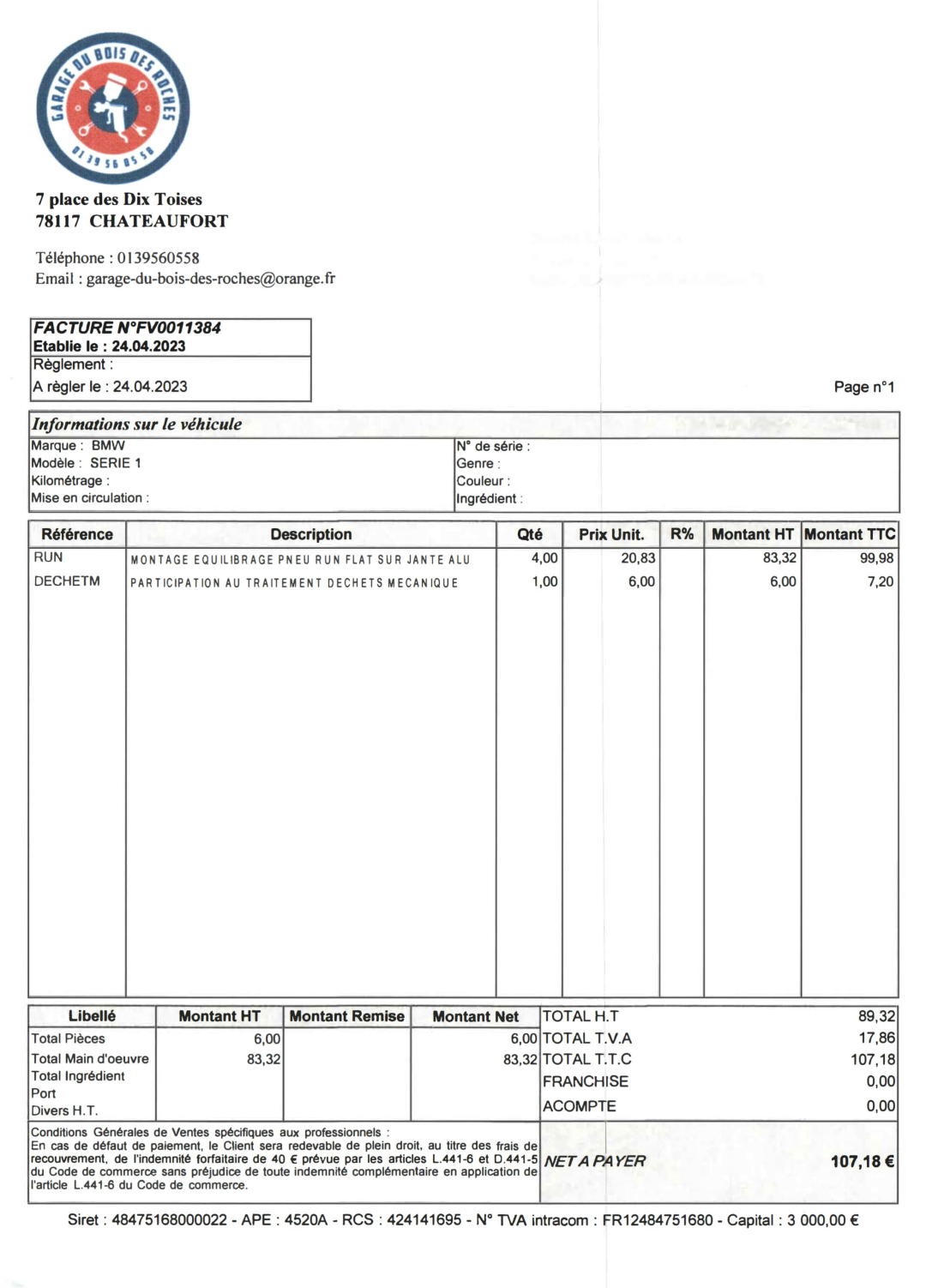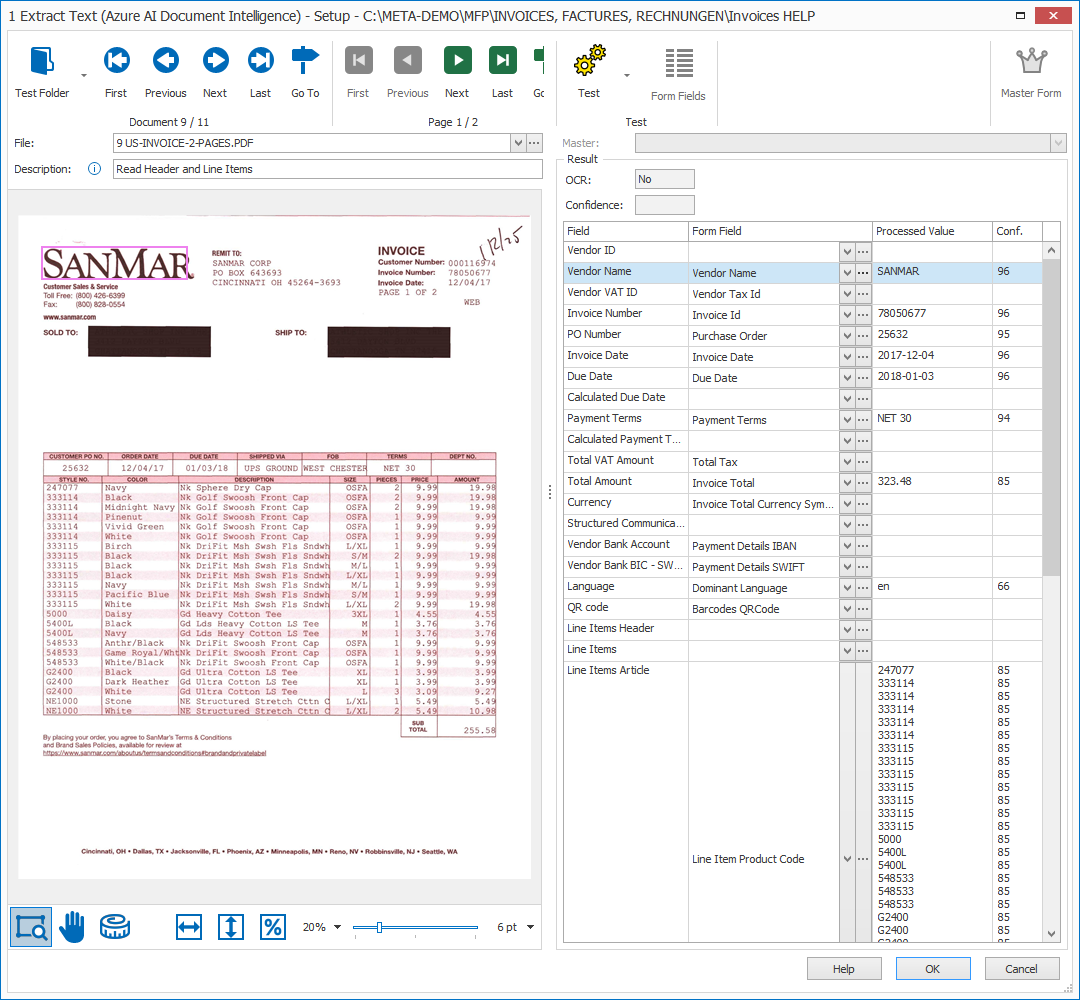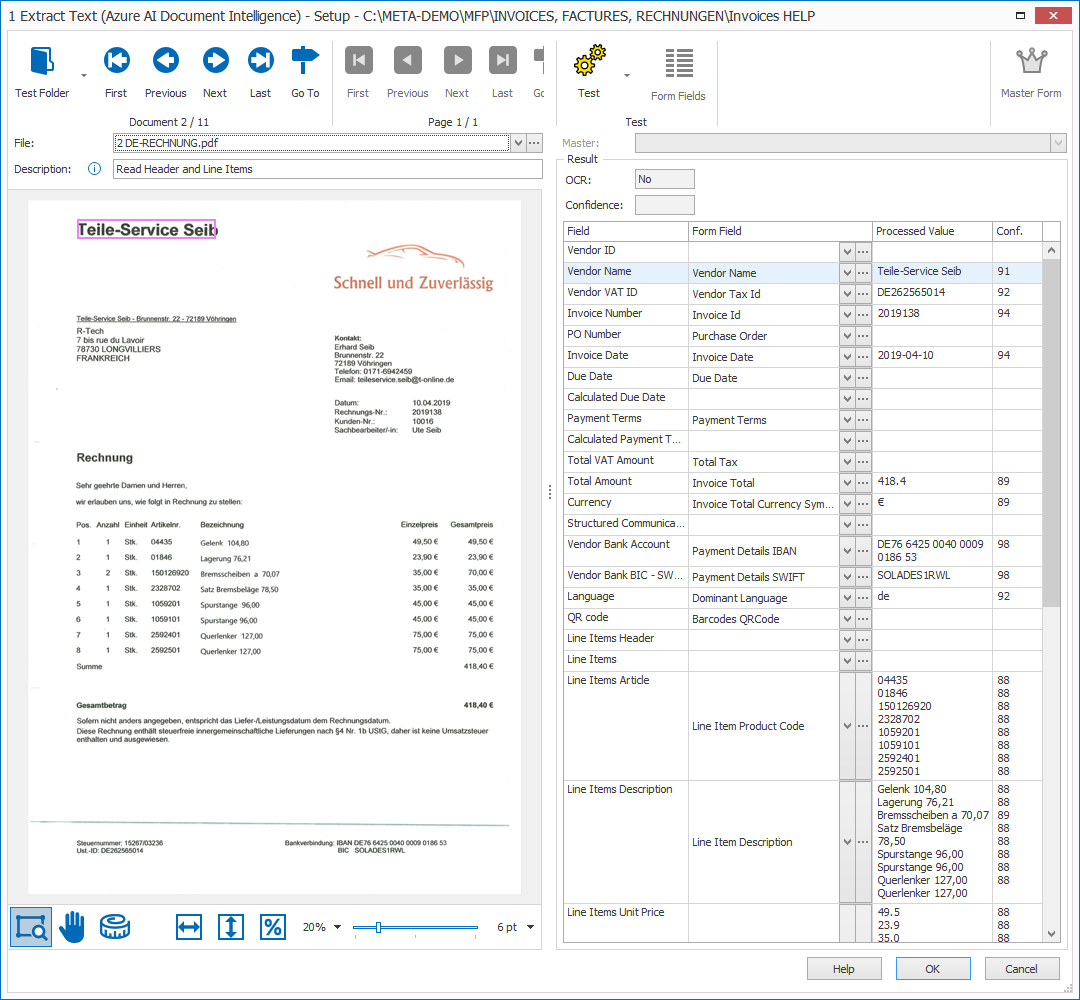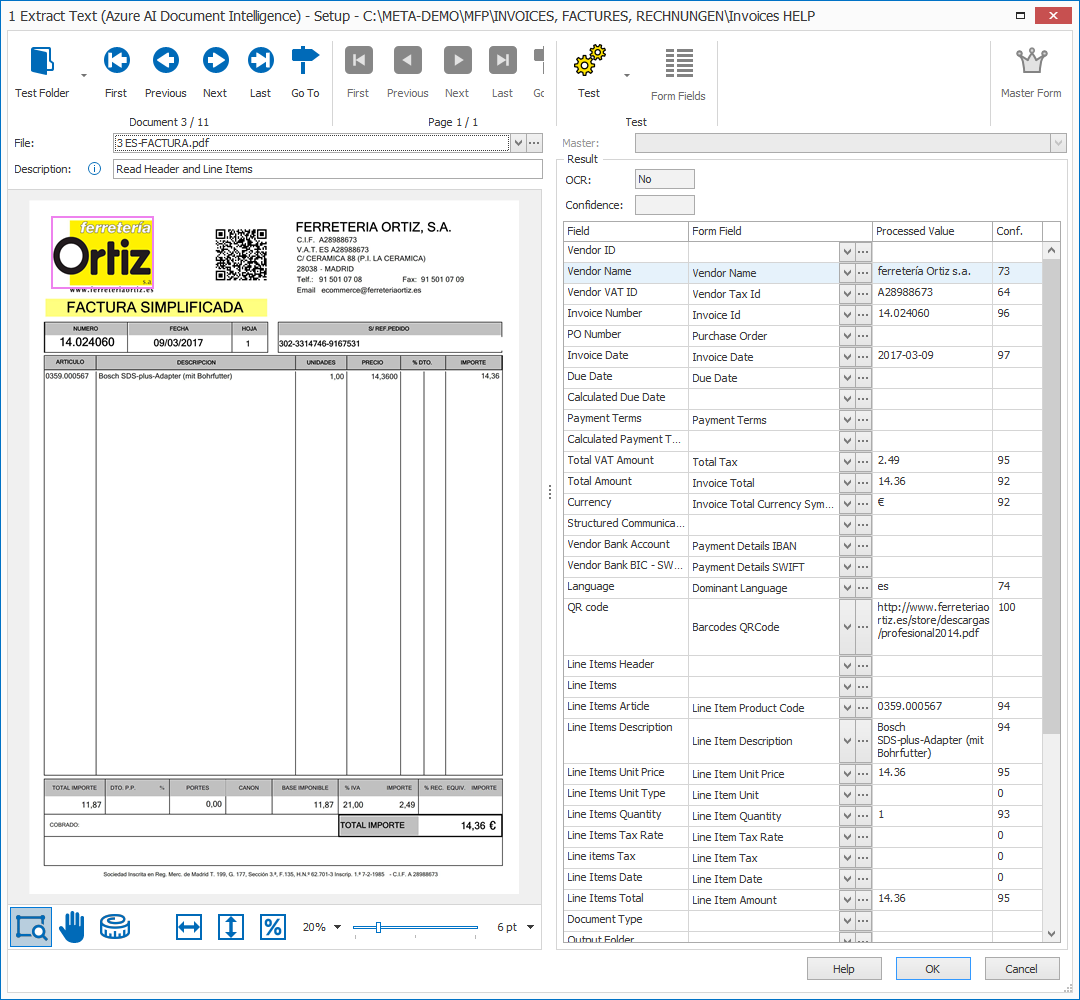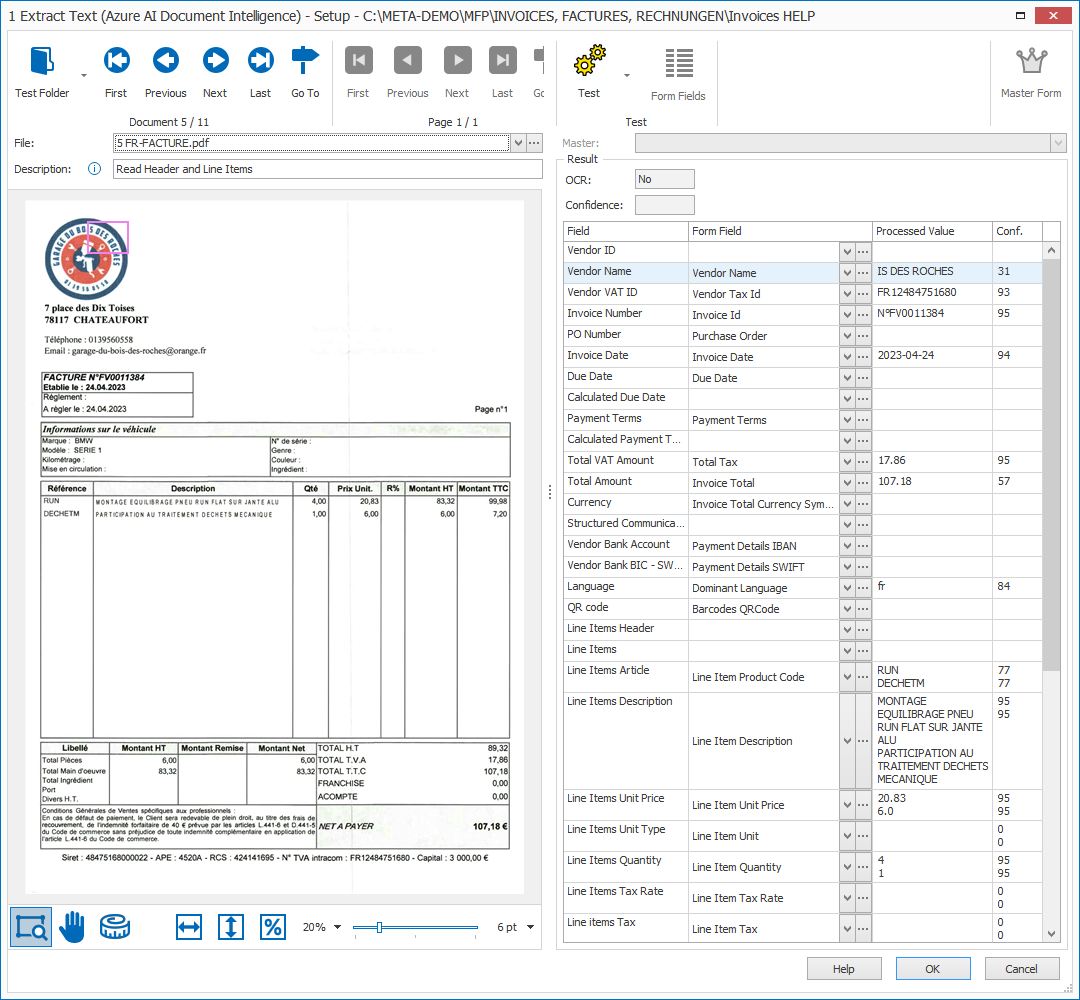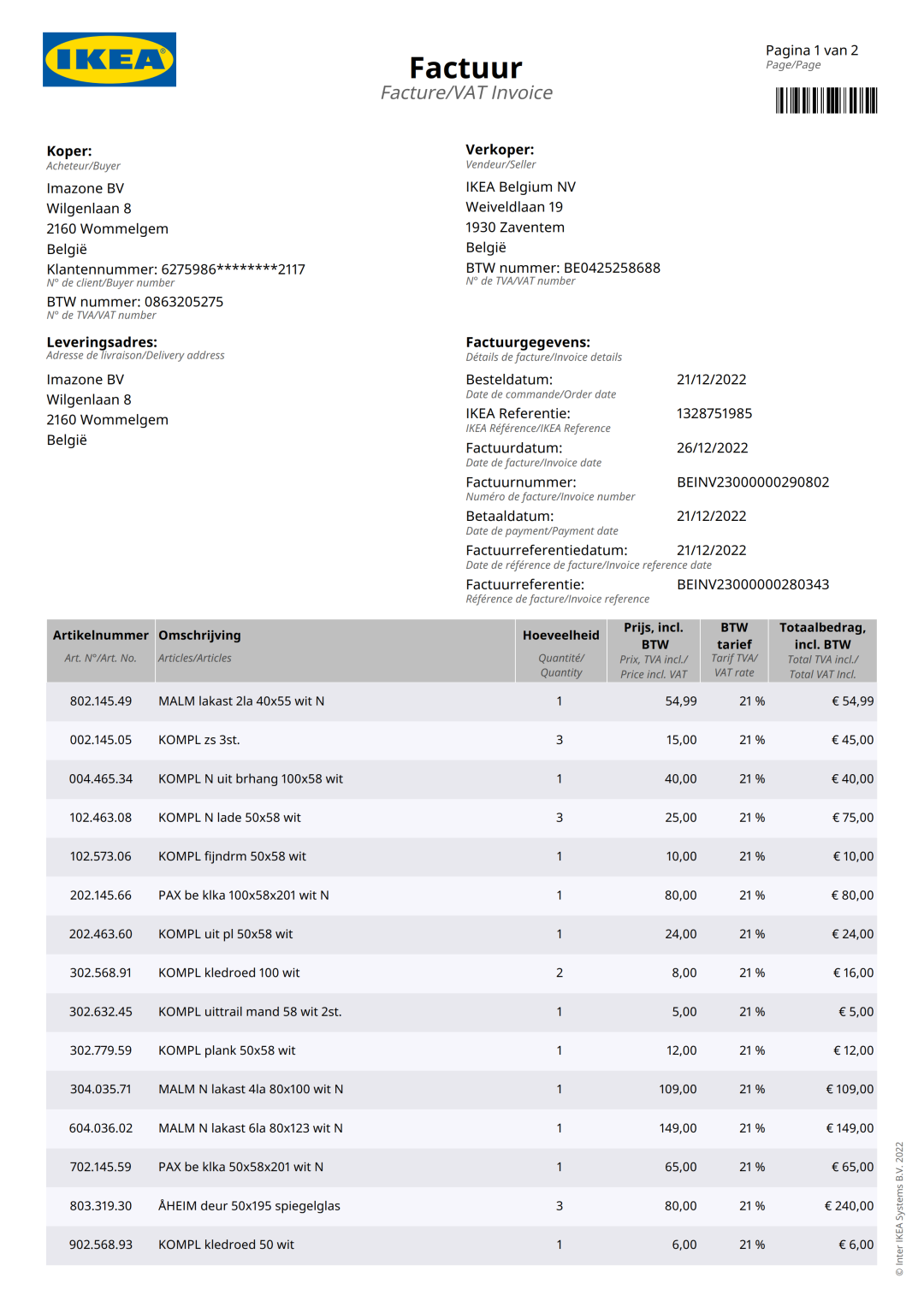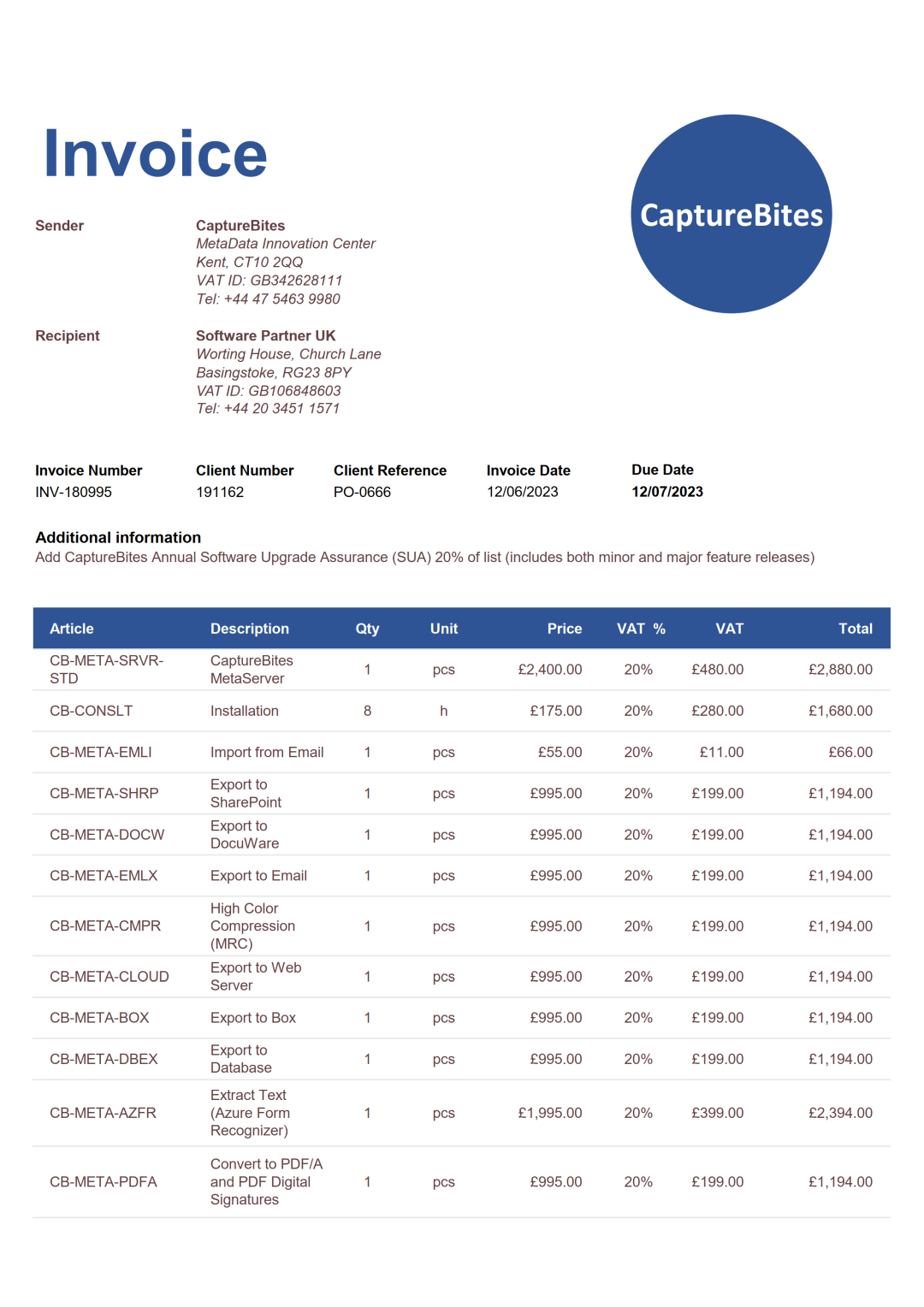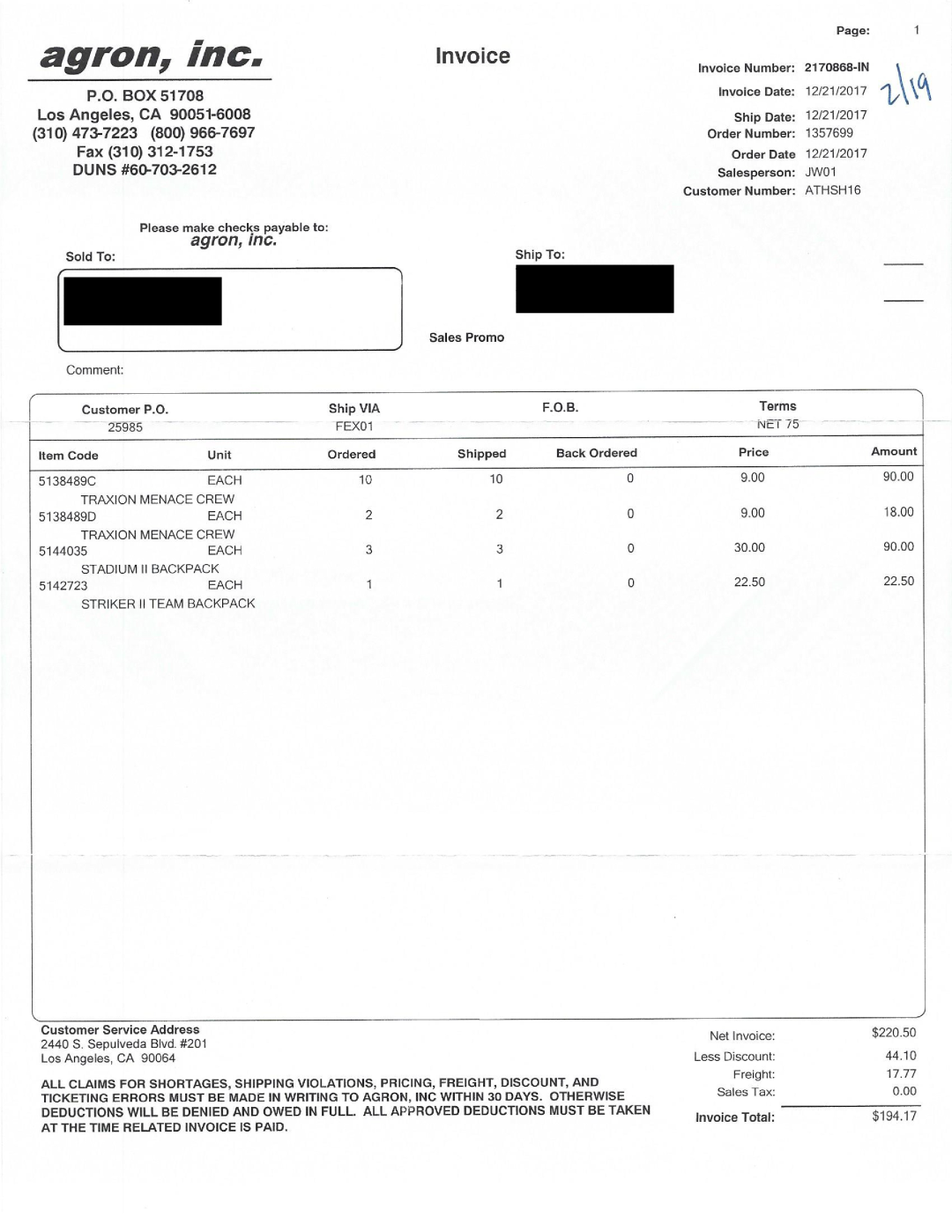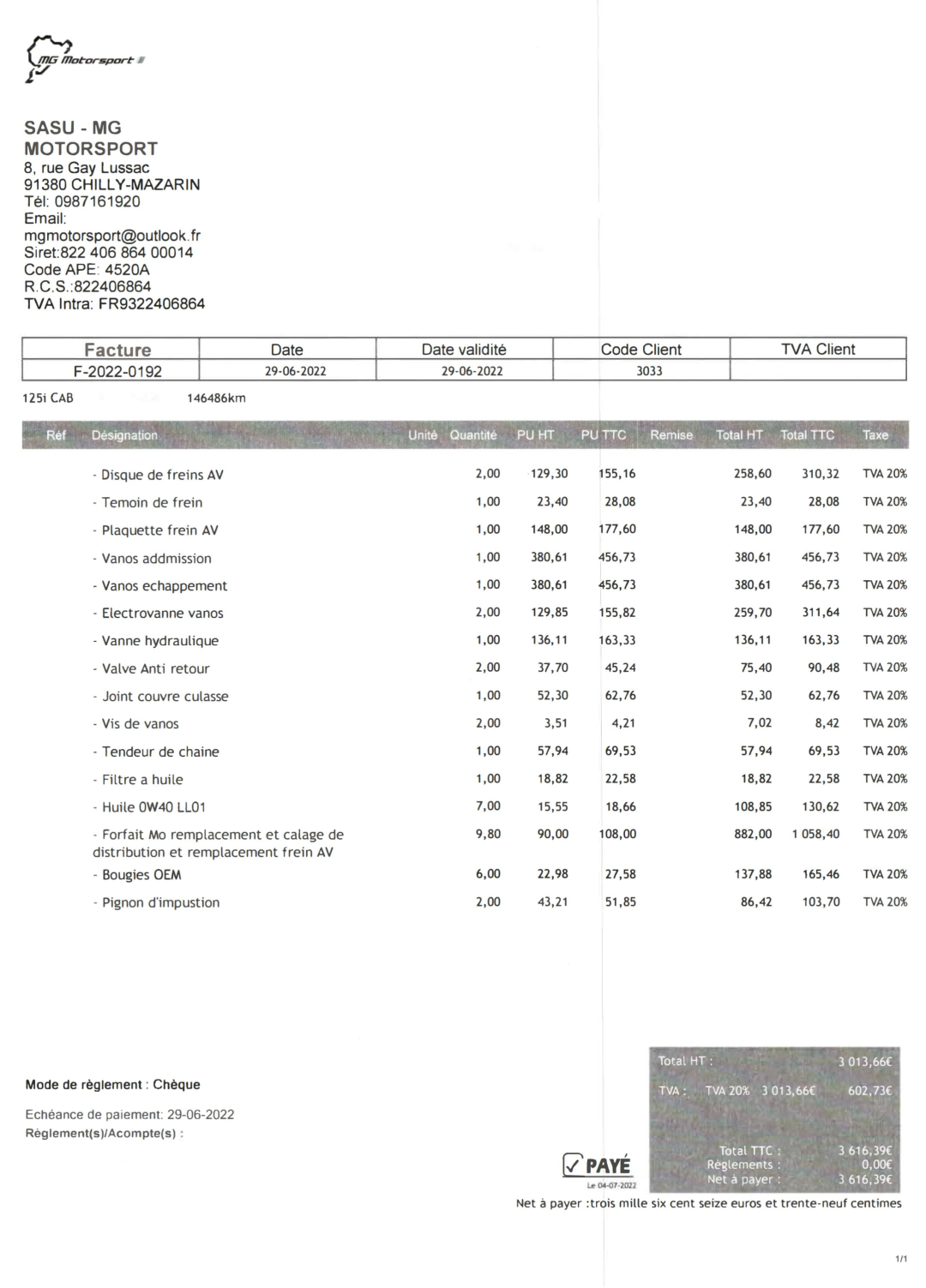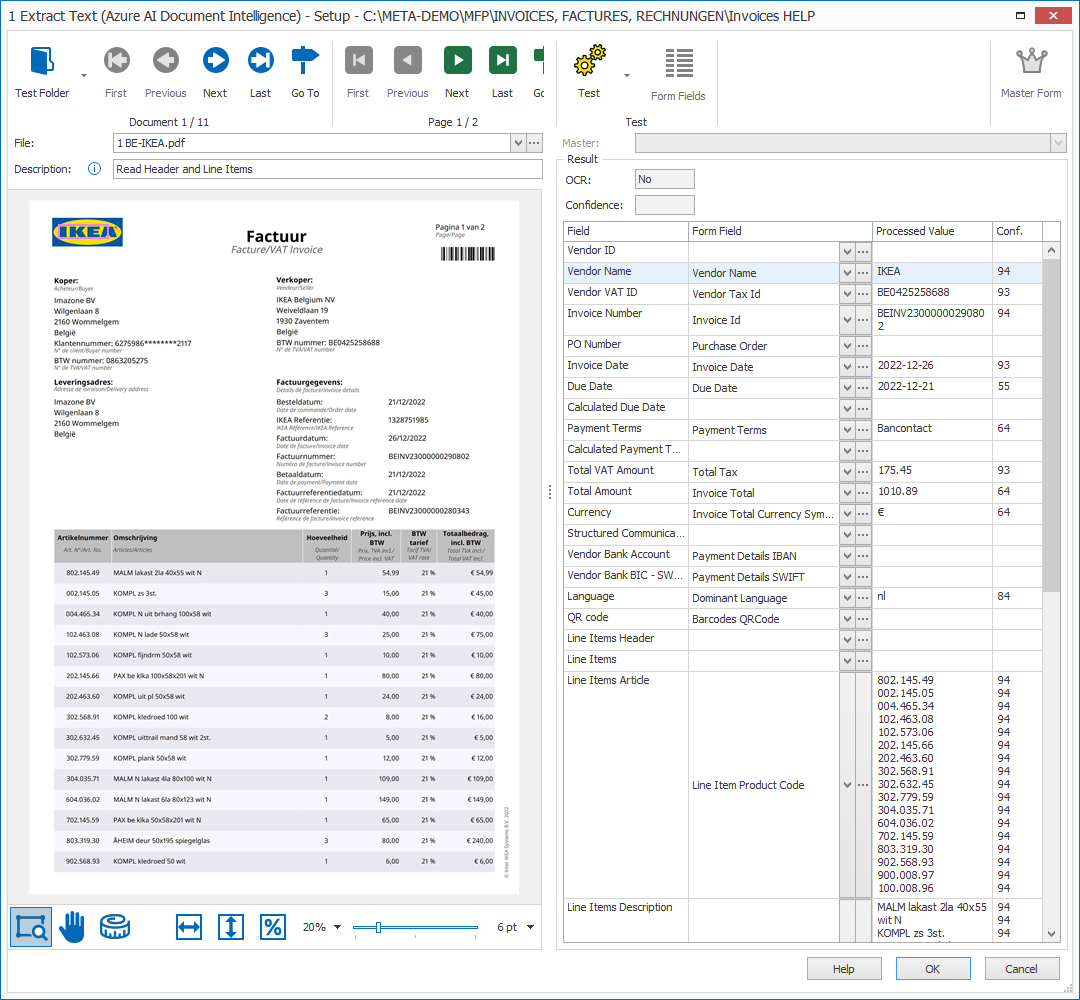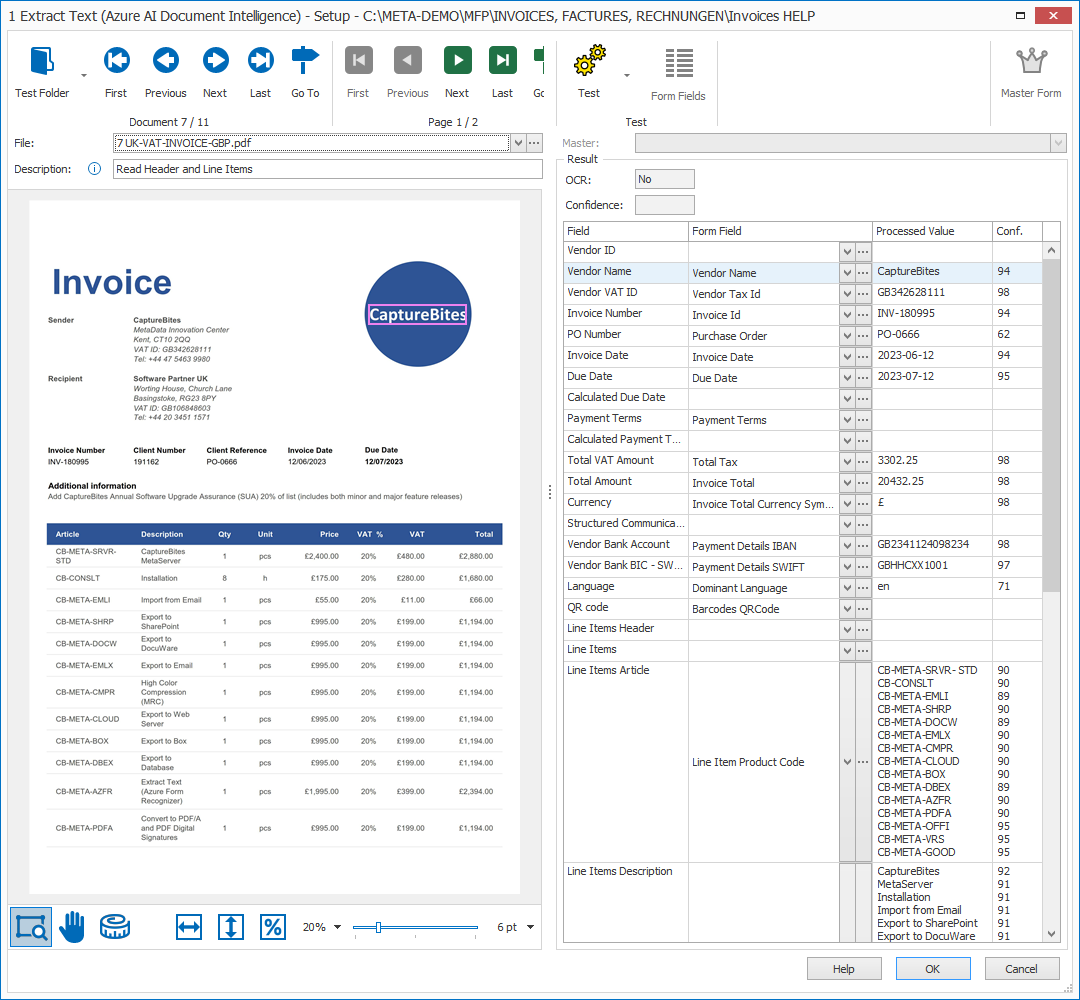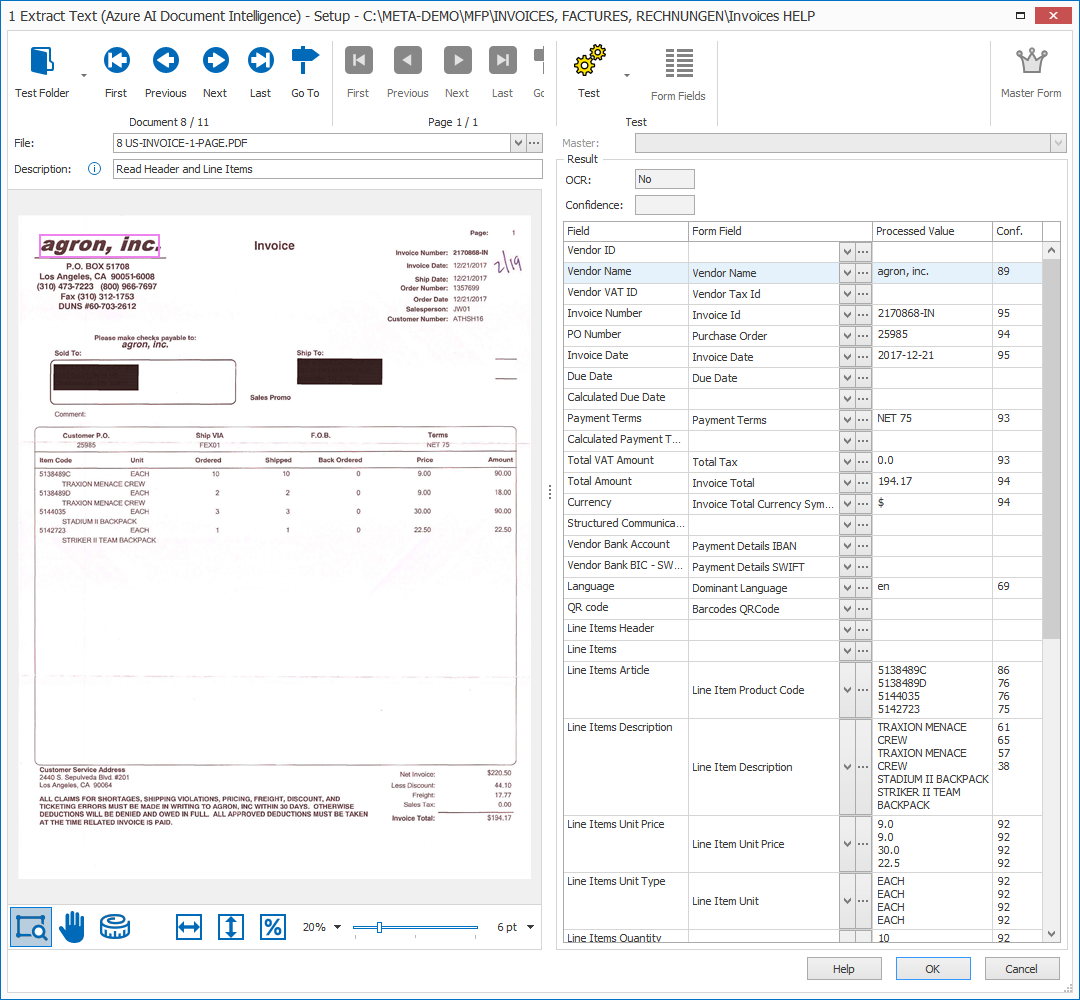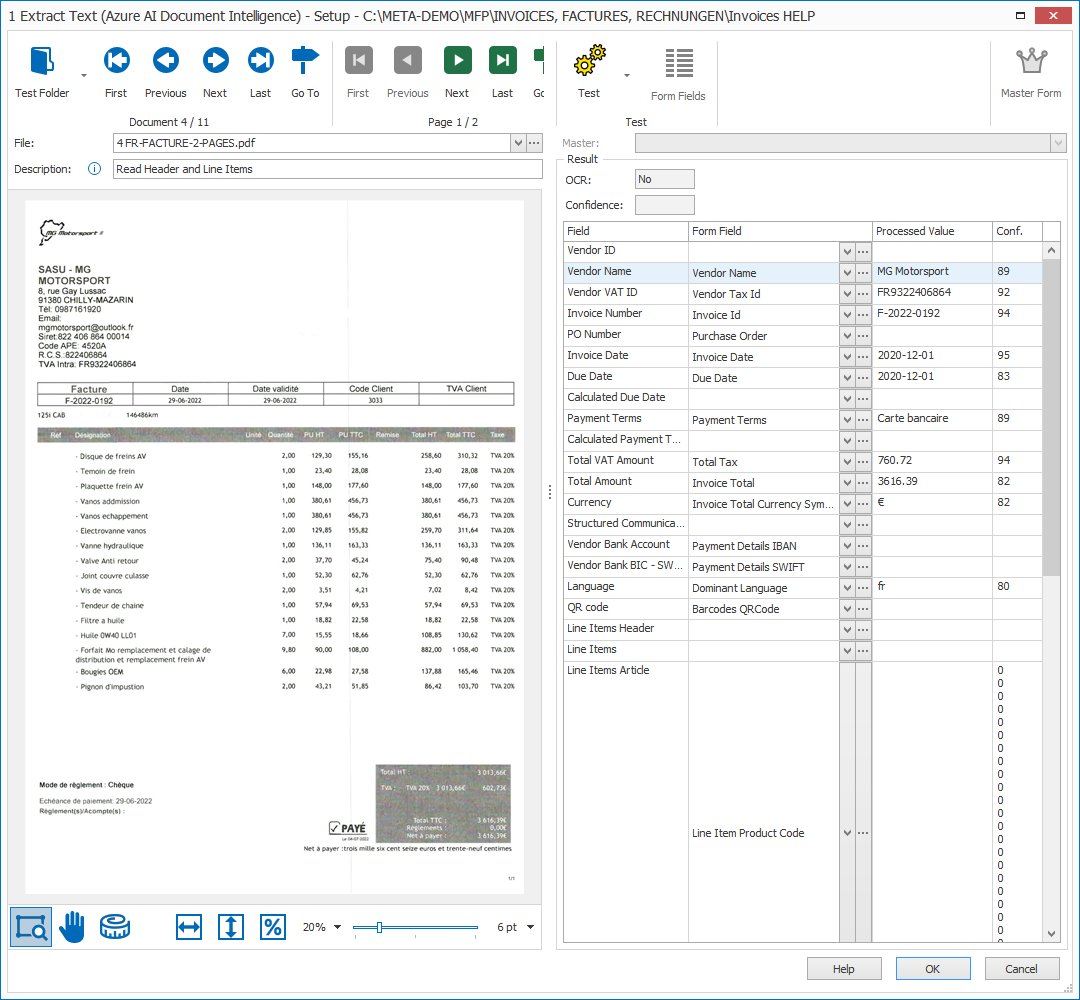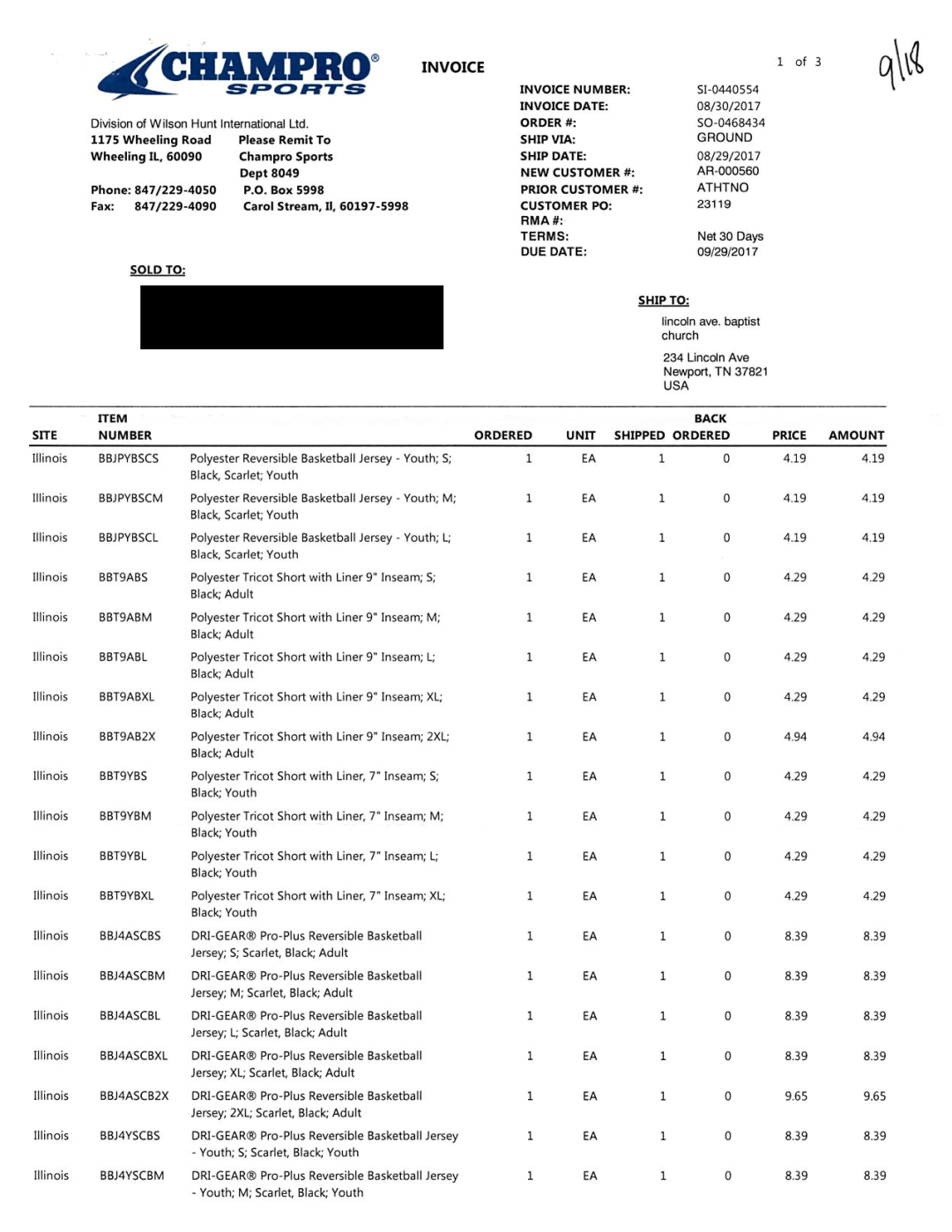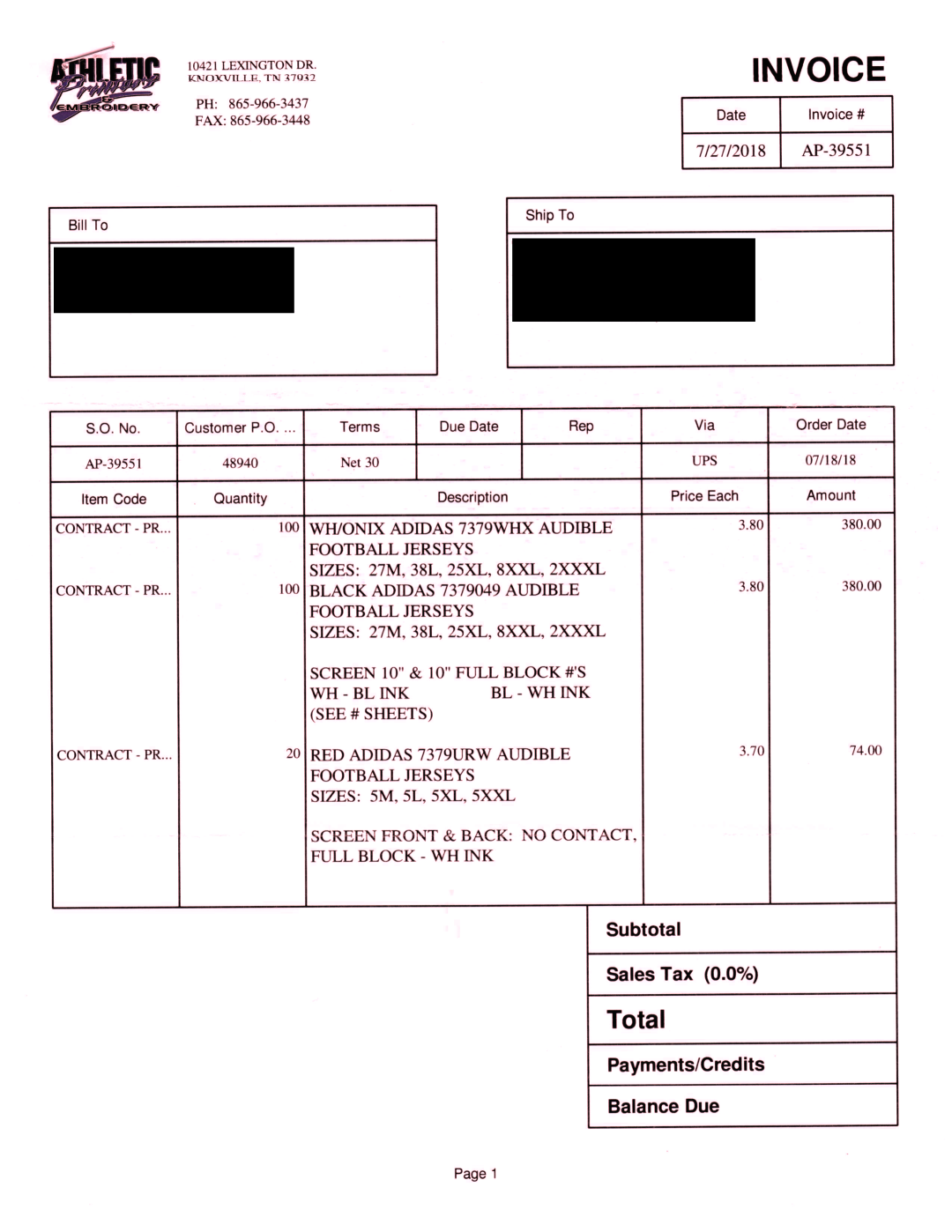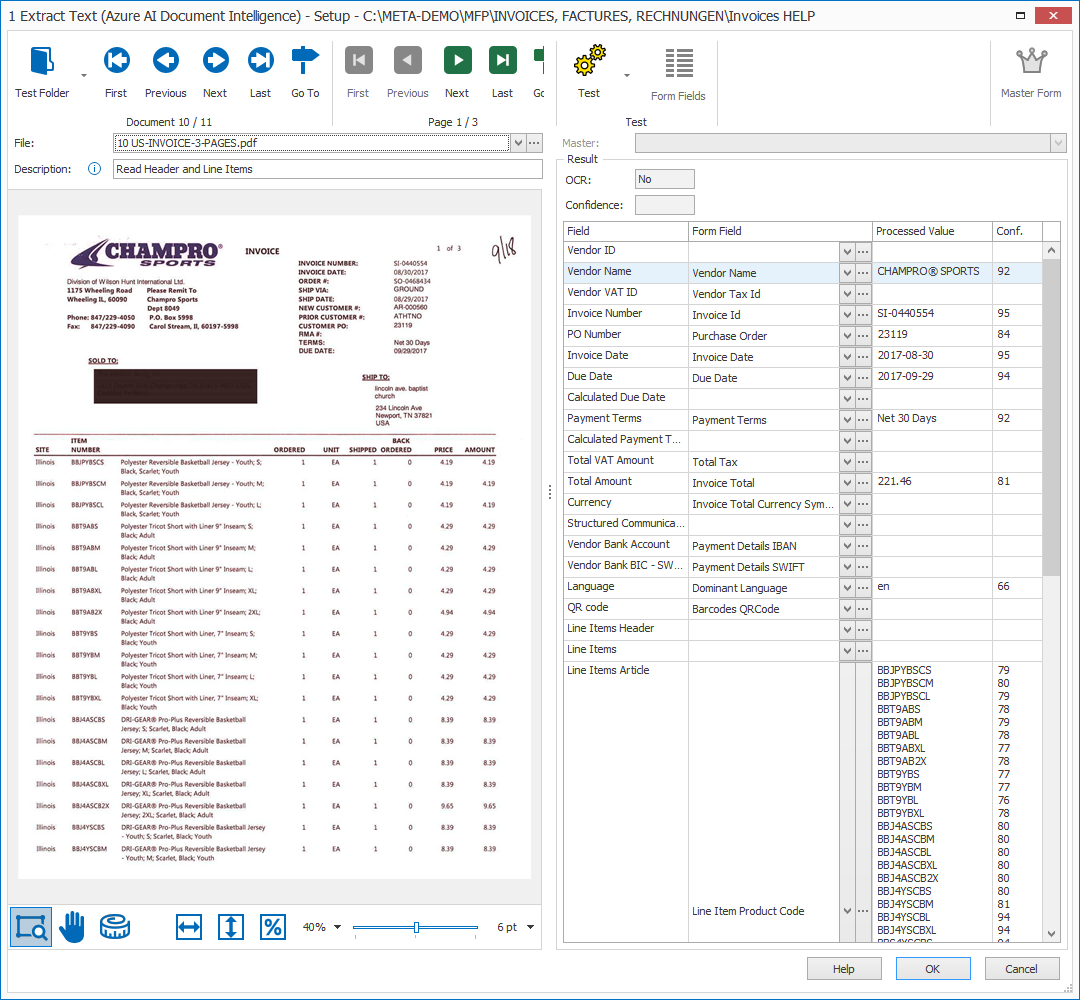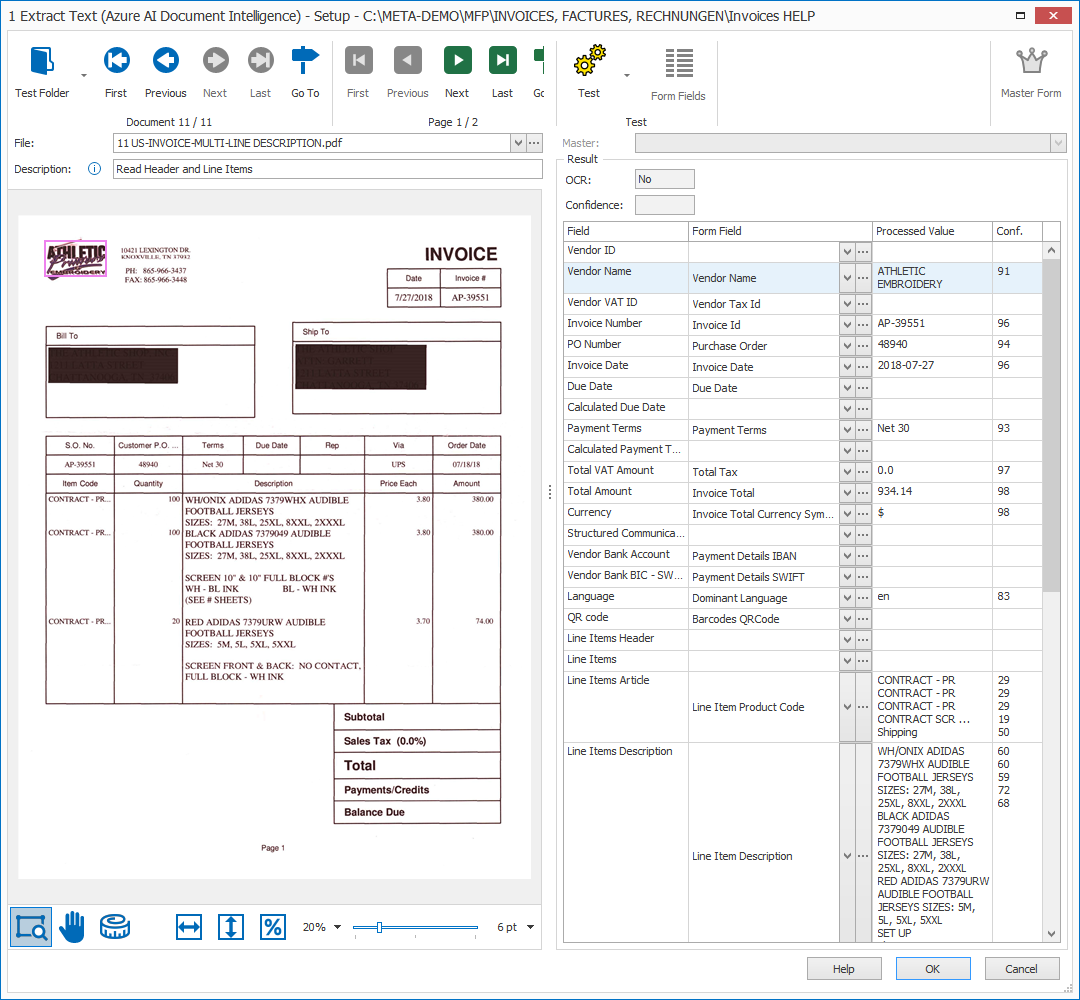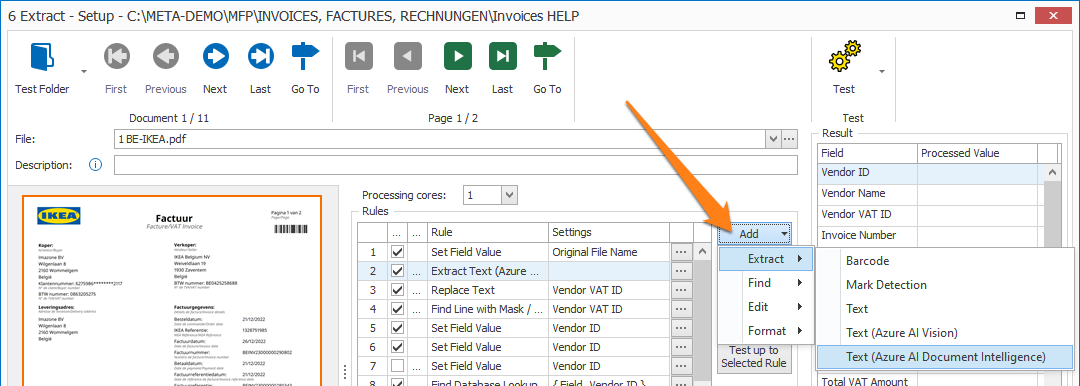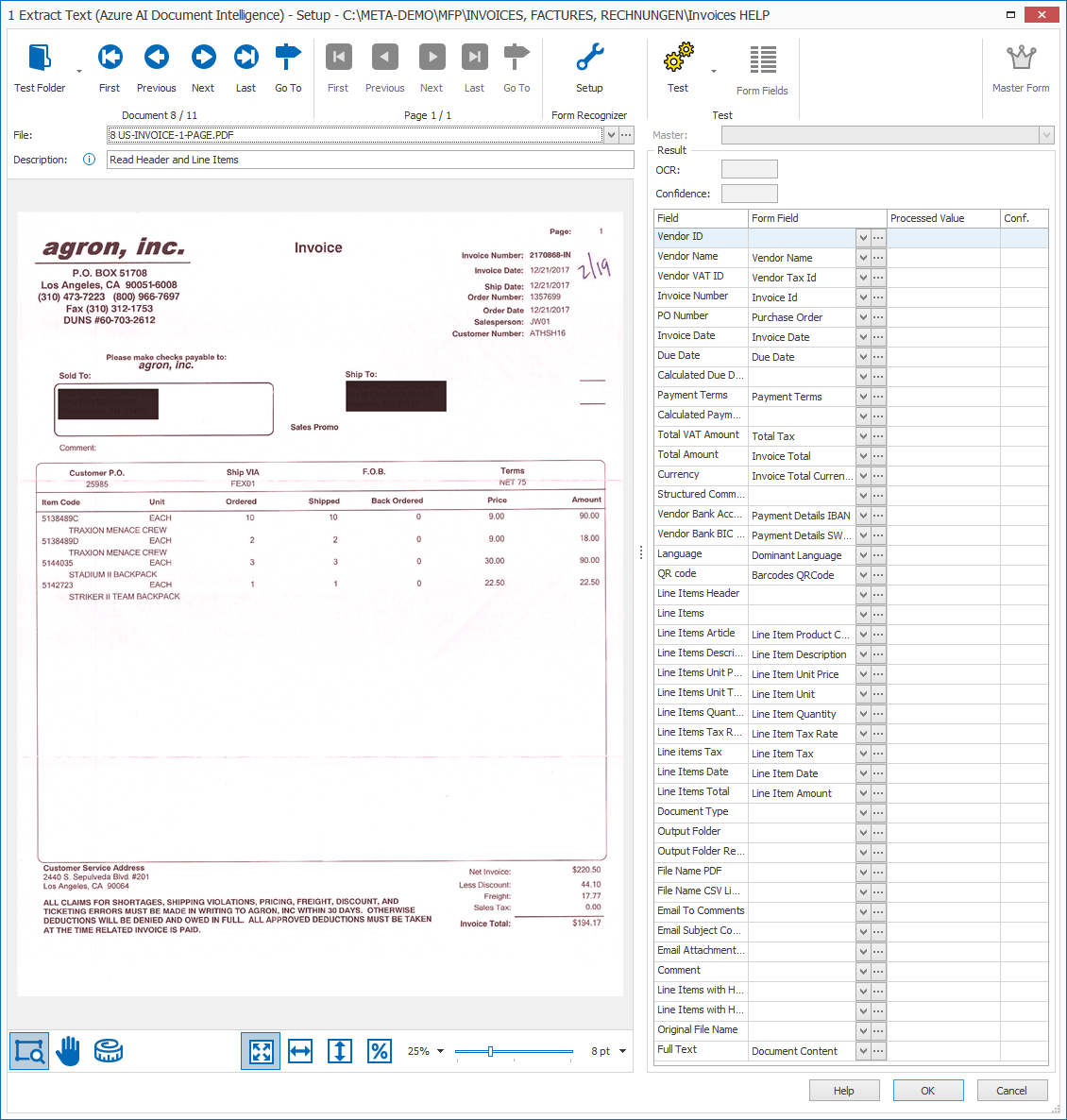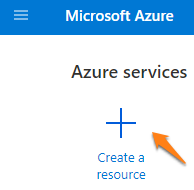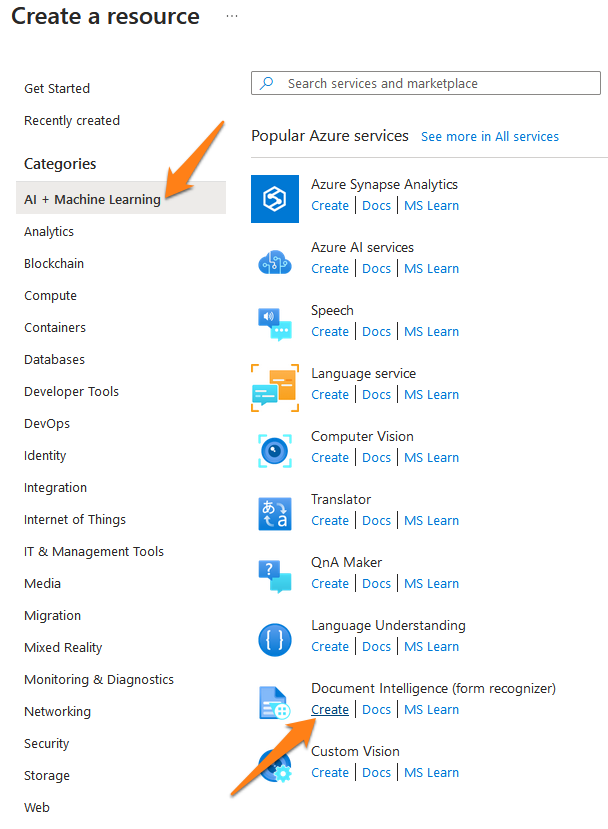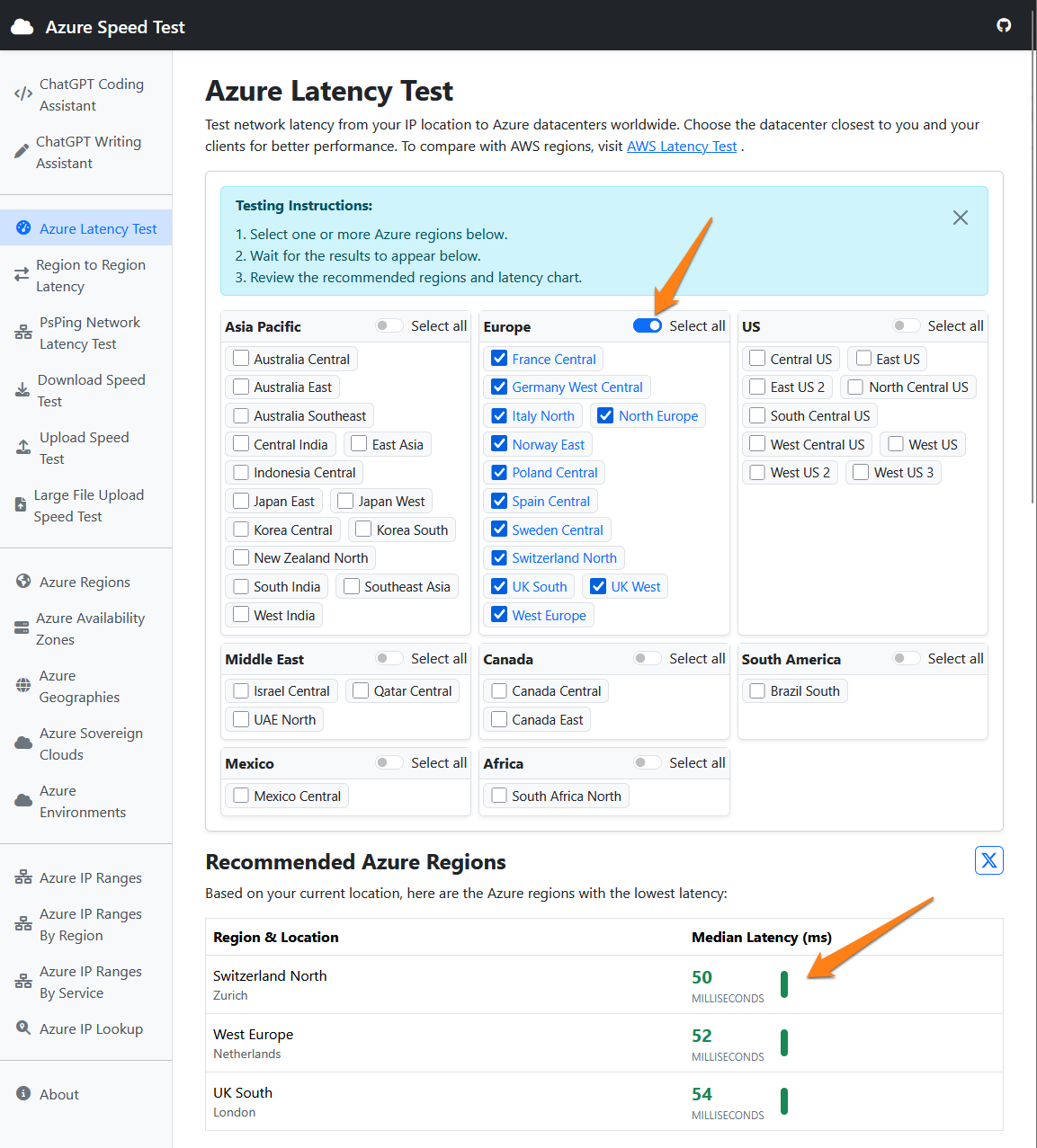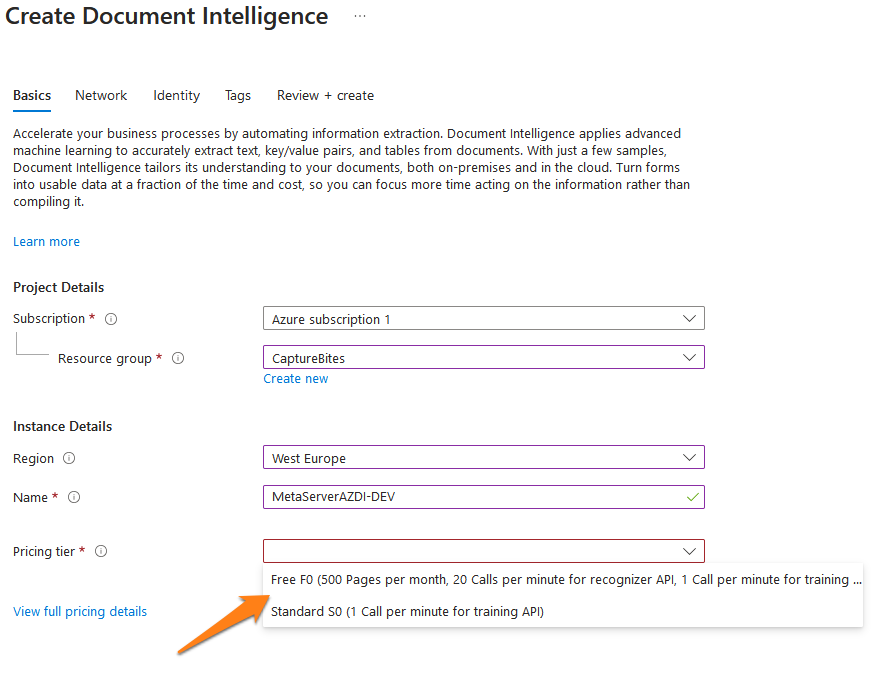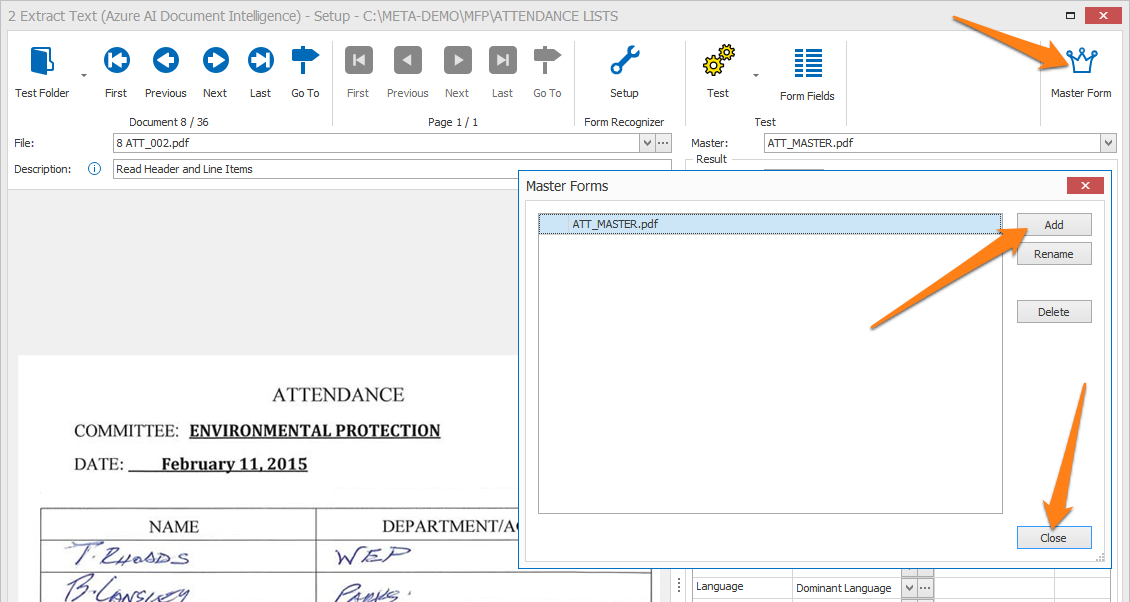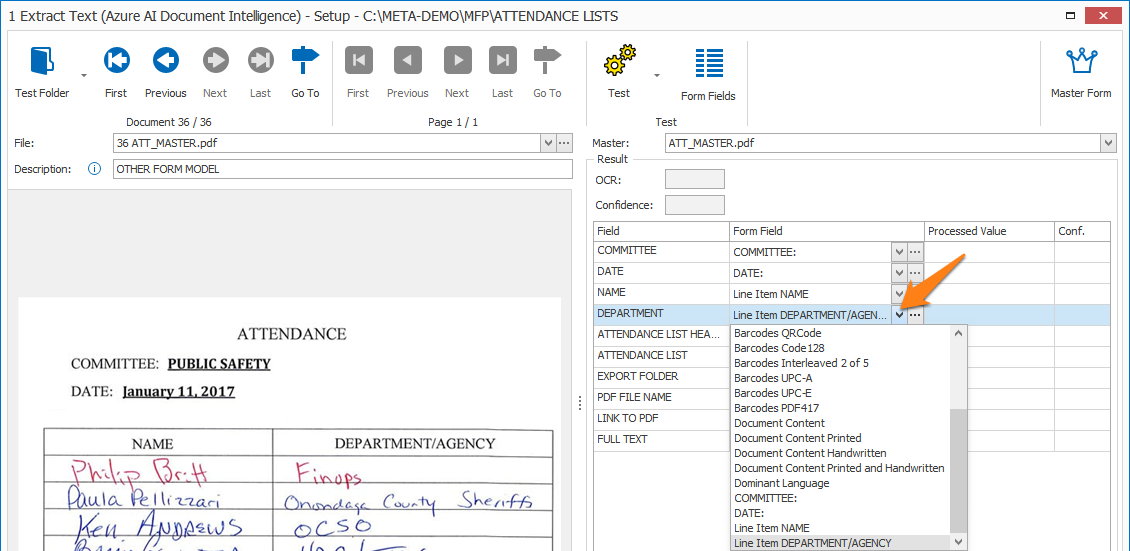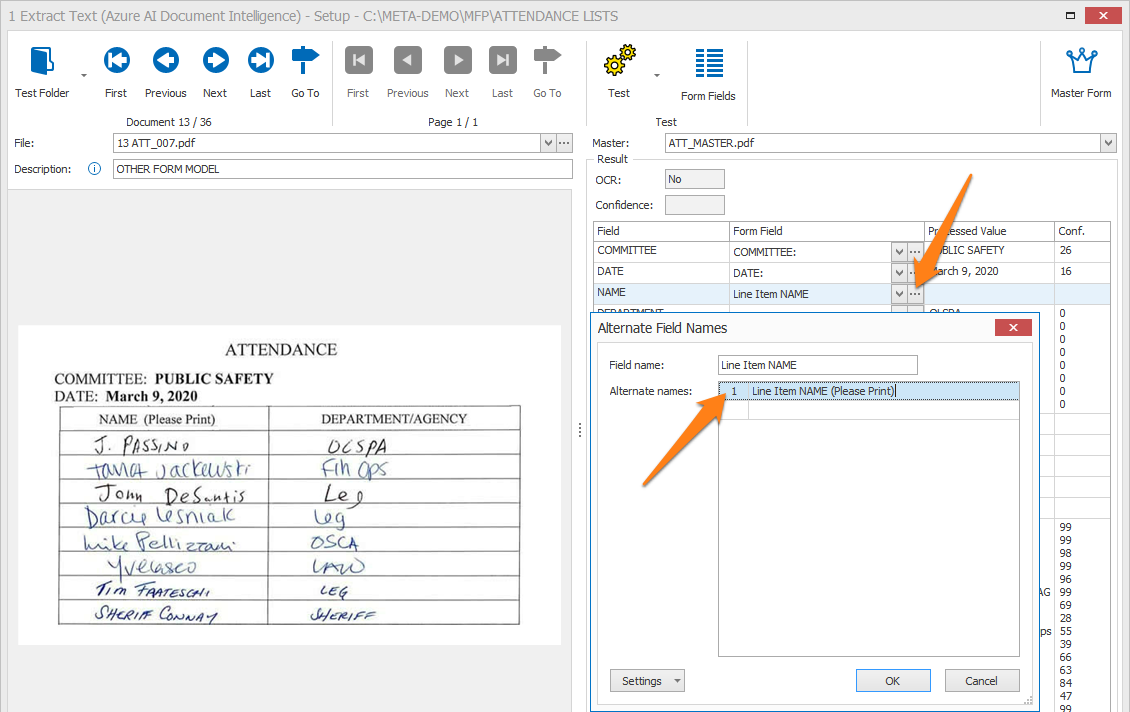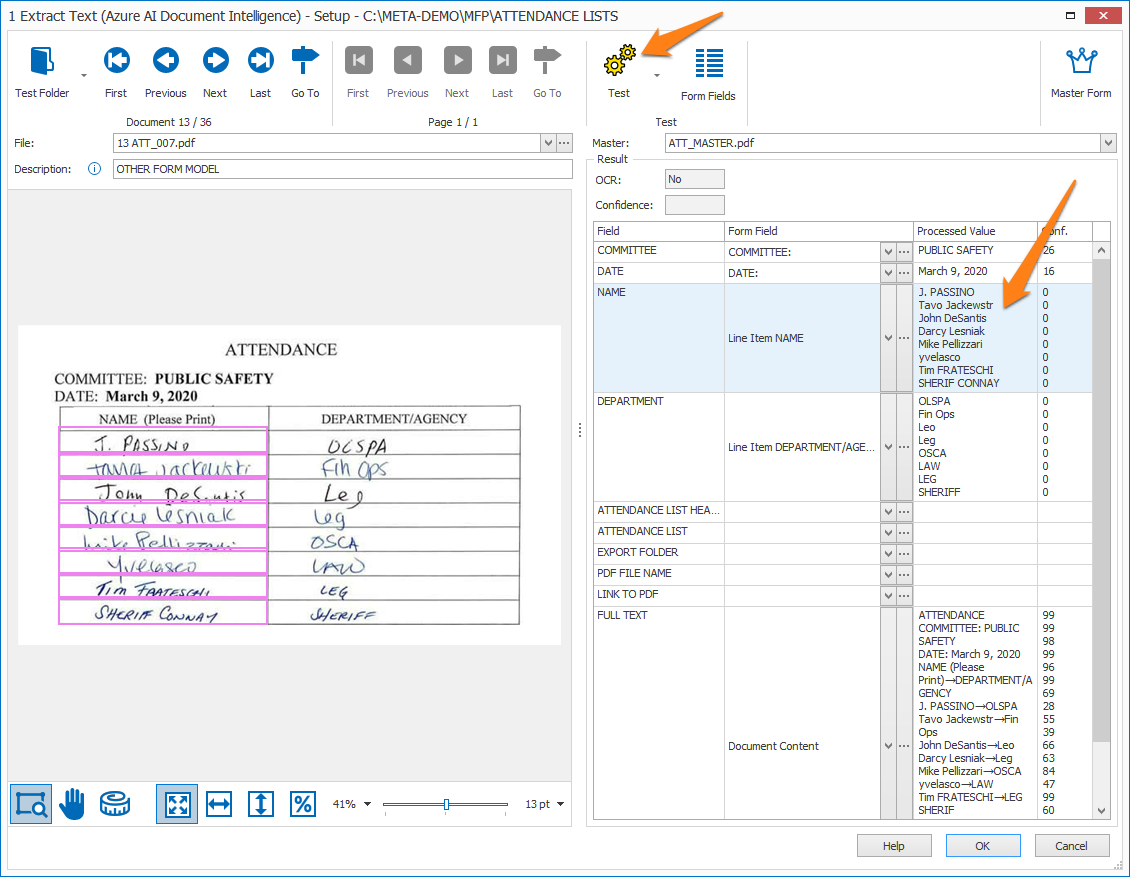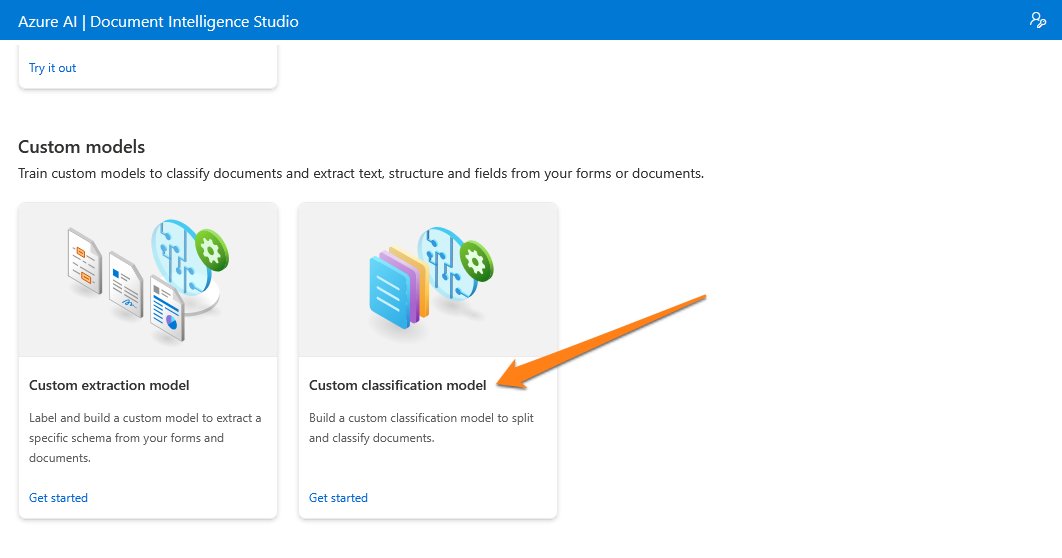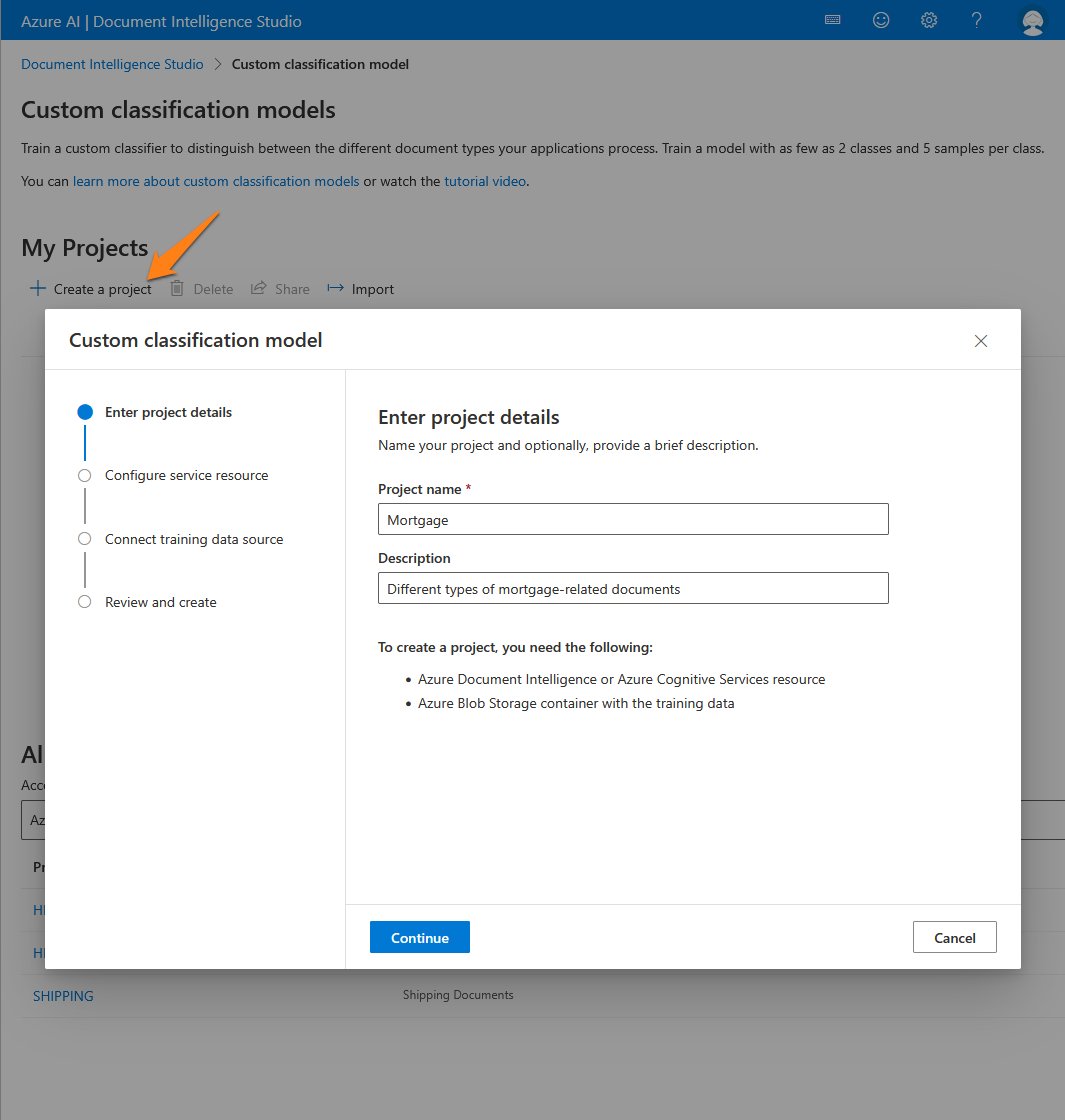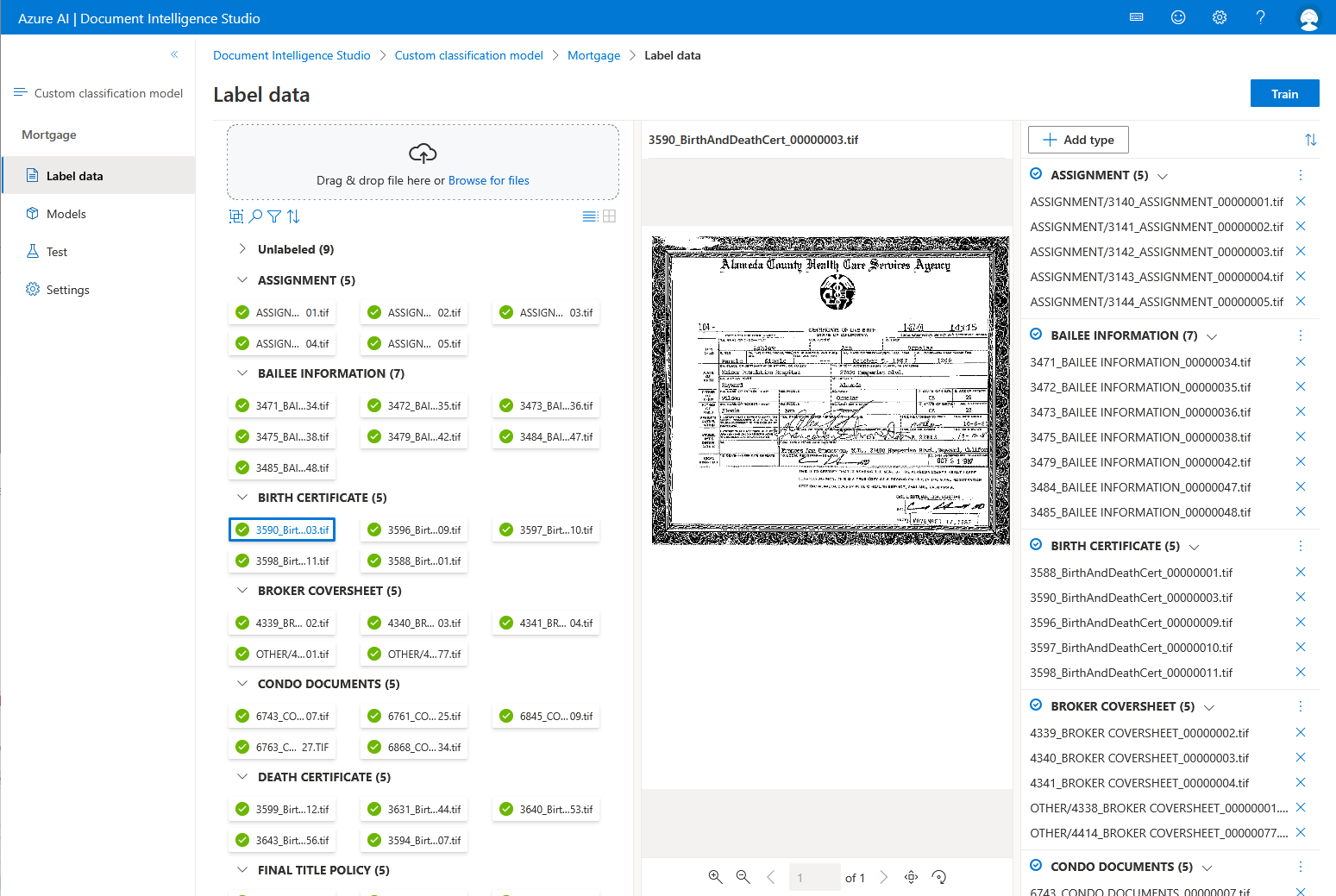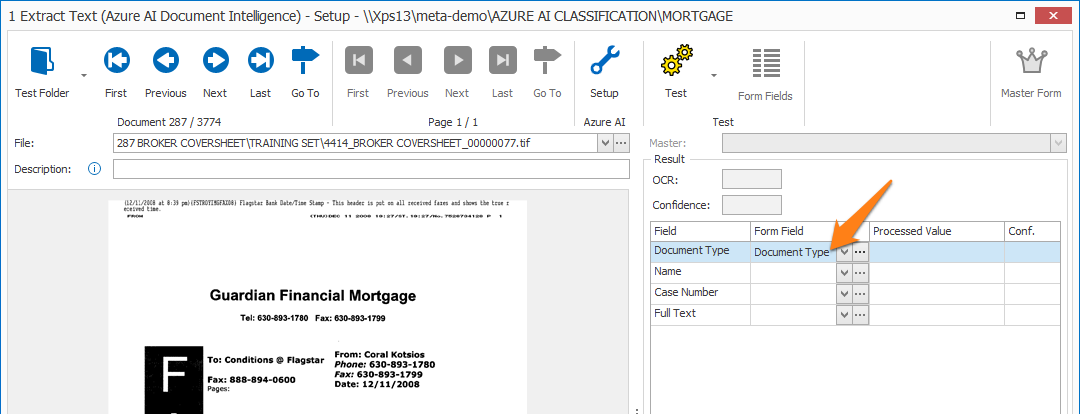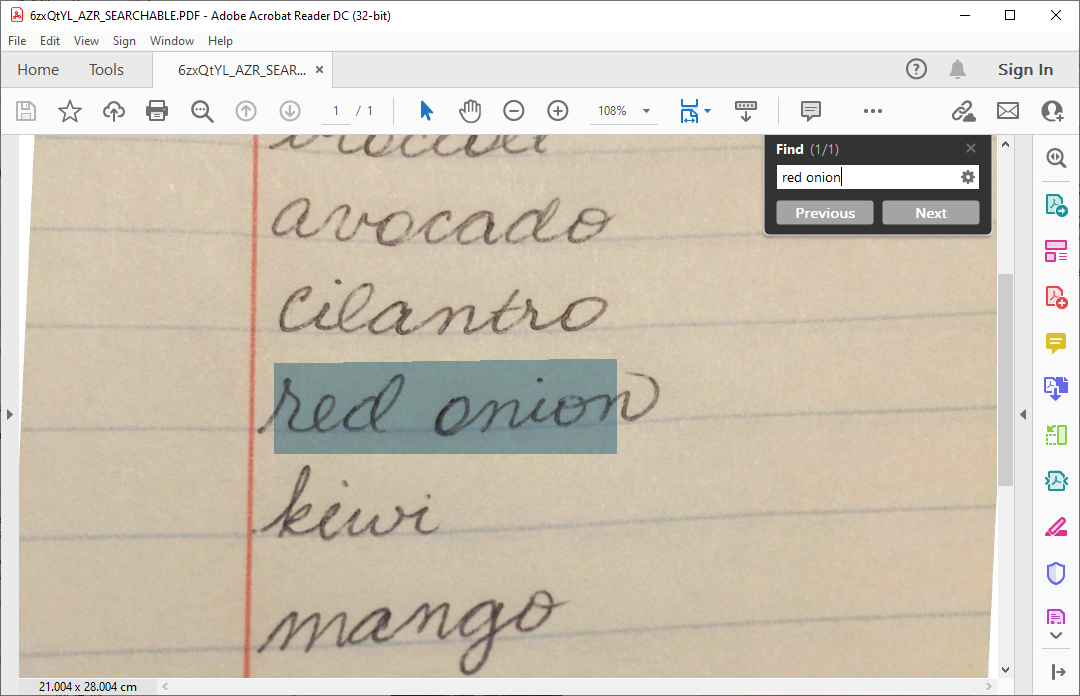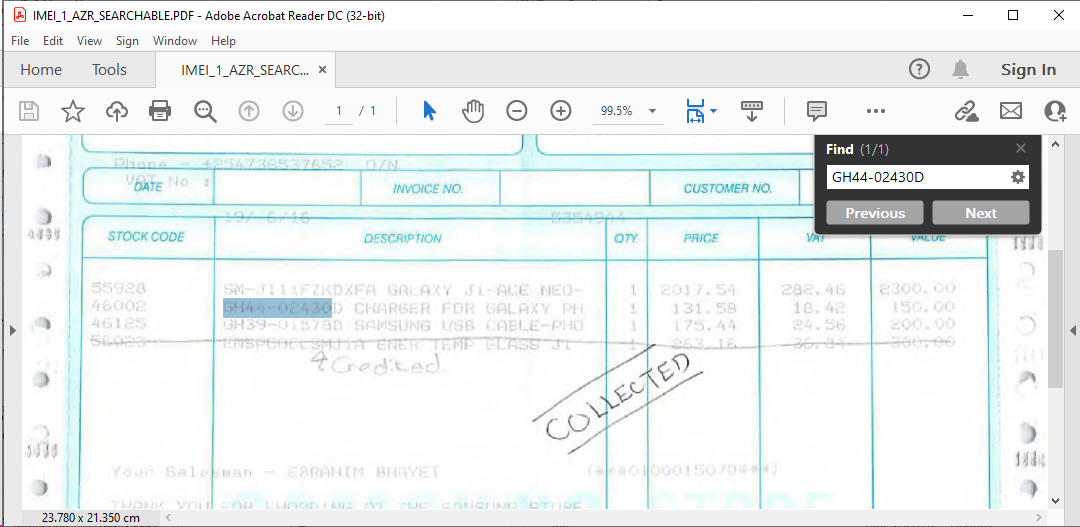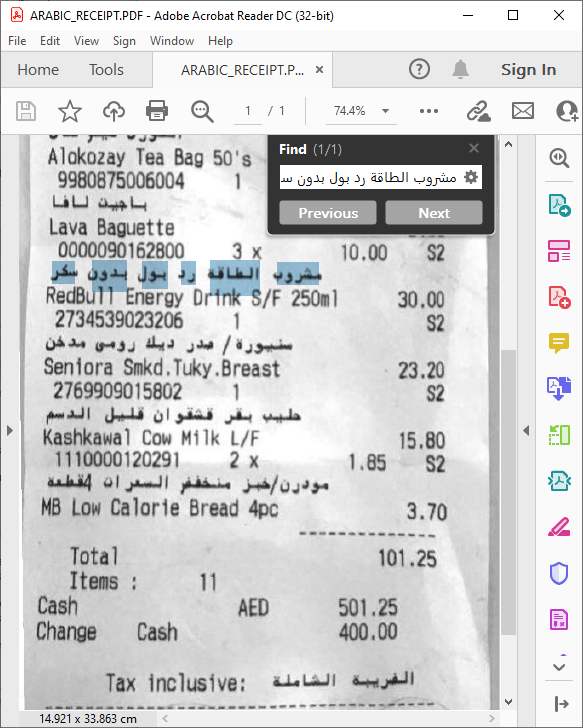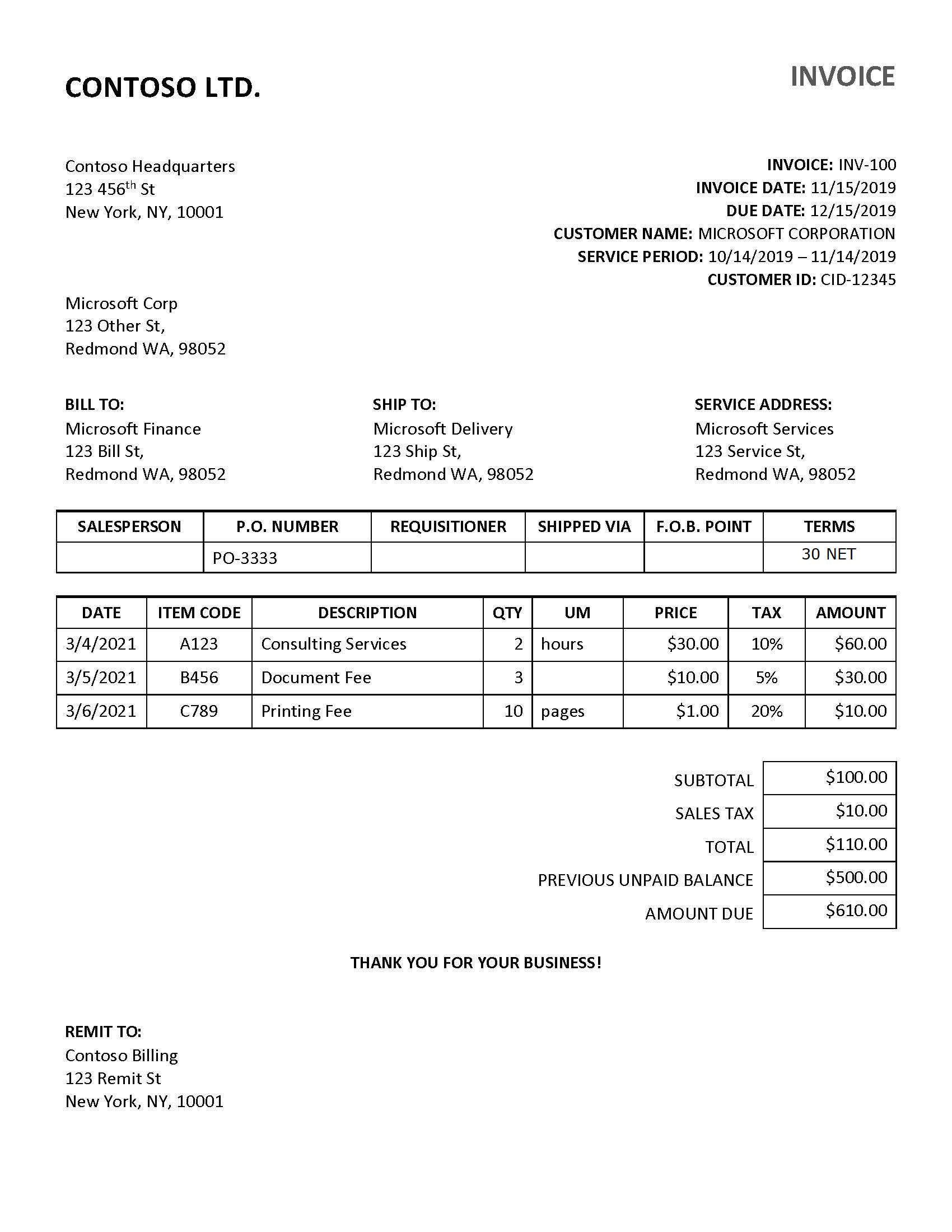MetaServer > Help > Extract > Extract Text (Azure AI Document Intelligence)
120-150 Extract – Extract Text (Azure AI Document Intelligence)
With MetaServer’s Extract Text (Azure AI Document Intelligence) rule (FKA “Azure Form Recognizer”), you can automatically extract header data, key values and line items from forms, like invoices, and store that extracted data in fields. This is done through Azure AI Document Intelligence’s prebuilt models. These do not require any training or configuration.
It reads machine printed text, cursive handwriting, barcodes and CMC7 text (except for the Other Form model). It’s exceptional in handling inferior quality images like those photographed with a smart phone and smudged or damaged documents.
You can specify the pages where you want to extract information from. After the values have been extracted, you can apply other Extract rules to clean up, format or adjust the values before sending it to the next action.
You also have the option to build your own Custom Classification model, using the Azure Document Intelligence Studio, to automatically classify and separate documents in a single step.
You can refer to the Azure AI Document Intelligence’s documentation for a more detailed list of the supported languages for each model.
Some examples (results are below each sample):
NOTE: To validate line items as a table with different columns, you need to merge and format all line items in 1 CSV field using a Format CSV rule. The CSV field would then contain all line items and / or header data in a CSV format.
For example:
“5138489C”,”TRAXION MENACE CREW”,”9.00″,”EACH”,”10″,””,”90.00″
“5138489D”,”TRAXION MENACE CREW “,”9.00″,” EACH “,”2″,””,”18.00″
“5144035″,”STADIUM II BACKPACK”,”30.00″,” EACH “,”1″,”3″,”90.00″
“5142723″,”STRIKER II TEAM BACKPACK”,”22.50″,” EACH “,”1″,””,”22.50″
Using a Validate CSV rule, it would look like this in validation:
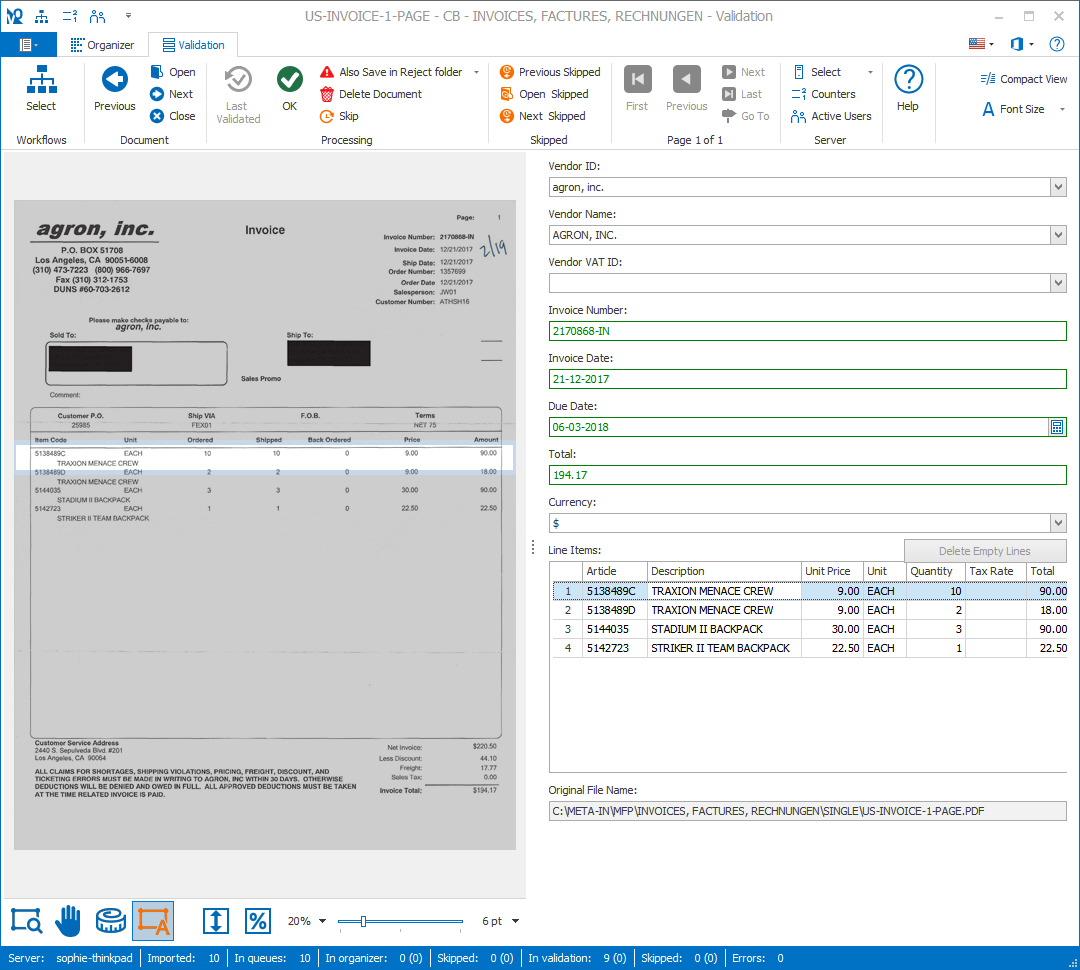
NOTE: You need to sign up for the Azure AI Document Intelligence service. Paid plans for the prebuilt models are available for 10$ per 1000 pages (S0 Plan for Prebuilt document types).
If you only use the Read model, paid plans are available for $ 1.50 per 1000 pages.
There is also a free, 1-year plan (F0) where you can test the engine with prebuilt models up to 500 pages per month for free.
IMPORTANT: The processing speed in the free plan is limited to only 1 call per 2 seconds and only reads 2 pages of the invoice. For the paid plan (S0 plan), the processing speed is 15 calls per second, which is 30 times faster than the free plan and reads all the pages of the invoice.
If you want to use your own Custom Classification model, the plan starts from $ 3 per 1000 pages. Building the model is $ 3 per hour. When you’ve prepared good samples, you will, at most, need to train your model a few times. The building time will only take minutes, not hours.
More detailed information about the pricing can be found here:
https://azure.microsoft.com/en-us/pricing/details/ai-document-intelligence/
For more information on how to apply for a key, please refer to the instructions below.
NOTE: For more technical information about how the Microsoft’s Azure AI Document Intelligence engine works (API, OCR, etc.) and how they handle Data privacy and security, please refer to the Microsoft Azure AI Document Intelligence documentation.
Extract Text rules are defined in a MetaServer Extract or Separate Document / Process Page action.
To add this rule, press the Add button and select Extract -> Text (Azure AI Document Intelligence).
TIP: The thumbnail on the right will follow you, so you can easily refer to the Setup window. Click on the thumbnail to zoom in.
How to sign up for a key
1) Log in to the Azure portal: https://portal.azure.com/#home
NOTE: If you don’t have a Microsoft or Azure account yet, you can sign up for free. You can find more info here:
https://azure.microsoft.com/en-us/free/
3) In the “AI + Machine Learning” section, create a “Document Intelligence” Resource:
NOTE: If you don’t have an Azure account, you can start one for free for 12 months. Just select “Start Free Trial” and follow the instructions.
4) Select the region closest to your system’s location, give your instance a unique name (this will be used in the endpoint URL) and select the pricing tier.
Which region should I choose to ensure the fastest possible Azure AI processing speed?
To check which Azure AI Service region is the fastest for your system, you can refer to the following online tool:
https://www.azurespeed.com/Azure/Latency
Select your system’s location’s continent and, after a few seconds, it lists each of the selected regions’ available Azure AI Service’s latency time, ranking from lowest latency (= fastest response time) to highest (= slowest response time).
In the example below, “Switzerland North” and “West Europe” are the regions with the fastest response time.
You can choose between 2 pricing tiers* for the Azure AI Document Intelligence:
F0 plan (Free): 12 months Free (500 pages/month)
– If you use the invoice model with the free plan, maximum 2 pages for each invoice will be processed.
– The page file size must be less than 4 MB.
– With the 12 month free plan, the Azure server can only handle 1 call every 2 seconds for the recognizer API. Because of this speed limit, we recommend to run extraction and separation only on one core with the free plan.
– Every 28th of the month, the counter is reset to 500 pages.
– When you run out of free calls before the 28th of the month, MetaServer will move documents to the Error tab and will report to wait until the 28th of the month to continue processing documents or to switch to a paid plan.
– Documents that ended up in the errors tab, can be reprocessed with a paid plan or retried when the free counter is reset on the 28th of the month.
– After the 12-month period, you will receive an email from Microsoft one month before the expiration, stating that the 12-month free service is about to expire and will stop working.
You will then need to switch from your free plan to a “pay-as-you-go” S0 plan (see below). You have 30 days to switch from your free plan to a “pay-as-you-go” S0 plan or to stop using the service.
S0 plan: Pay-as-you-go ($10 per 1000 pages for prebuilt models, $1.50 per 1000 pages for the Read model or $3 per 1000 pages for a Custom Classification model*)
– The page file size can be up to 500 MB.
– The Azure server can handle 15 calls per seconds. You can run Extraction and Separation on multiple cores with a paid plan.
– Microsoft only charges for READ calls. GET calls are free
– For high volumes, starting from > 20.000 pages / month, you can find special pricing here.
IMPORTANT: Besides the subscription fee, building a Custom Classification model is $ 3 per hour. When you’ve prepared good samples, you, at most, need to train your model a few times. The building time will only take minutes, not hours.
More detailed information about the pricing* can be found here:
https://azure.microsoft.com/en-us/pricing/details/ai-document-intelligence/
* = The Azure AI services subscription prices are set by Microsoft and can be subject to change.
You can pay the subscription with a credit card or request to pay by check or wire transfer here:
https://docs.microsoft.com/en-us/azure/cost-management-billing/manage/pay-by-invoice
5) Press “Review + create” to check your Resource details. If they are correct, press the “Create” button.
6) You can find your resource’s Keys and Endpoint in your Microsoft Azure Dashboard. The “Go to Azure Portal” button will open the portal in your default browser.
The example below shows a resource called “MetaServerAZDI-DEV”.
First, add a description to your rule. Then, press the Setup button in the upper toolbar to setup the connection to your Azure AI Document Intelligence resource.
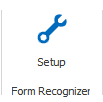
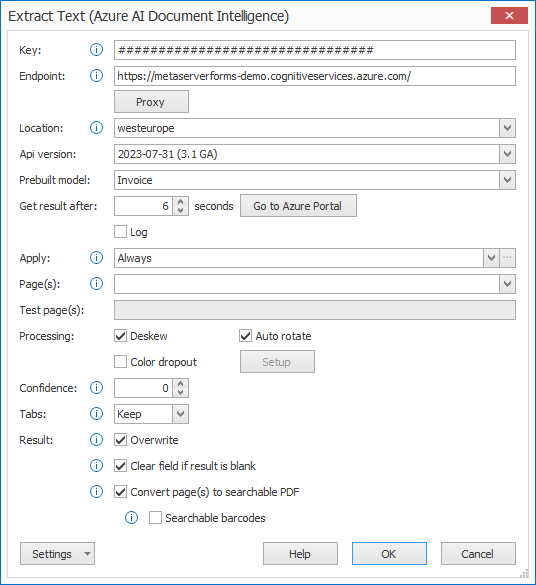
01 – Key, Endpoint, Location: enter your resource key, endpoint and select your location using the drop-down arrow. You can find this information in your Microsoft Azure Dashboard. The “Go to Azure Portal” button will open in the portal in your default browser.
The example below shows a resource called “MetaServerAZDI-DEV”.
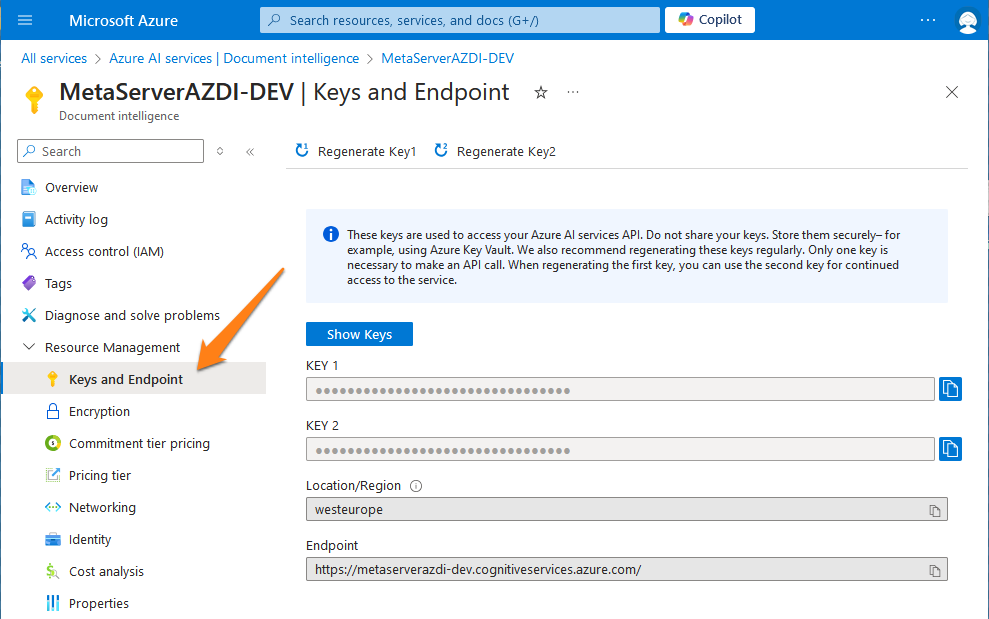
In your portal, you can also check your remaining calls. This can be useful to check if you’re not exceeding your current Microsoft Azure AI Document Intelligence’s pricing tier plan.
If you haven’t signed up for a key yet, please refer to the instructions above.
02 – Proxy: if you want to connect to a proxy server, press the Proxy button to open the setup window.

1) Type, Host, User name, Password: press the drop-down arrow to choose your proxy protocol and enter the connection settings to your proxy server. When in doubt, contact your IT department.
2) Port: enter the specified port of your Proxy server. When in doubt, contact your IT department.
03 – API version: here you can specify the API version for the Azure AI Document Intelligence.
Microsoft regularly releases new API versions. New versions add new functionality, like more supported languages or improved recognition etc.
You can find more details about what is new in Azure AI Document Intelligence’s current API here:
https://learn.microsoft.com/en-us/azure/applied-ai-services/form-recognizer/whats-new
The “Invoice” model automates processing of invoices to extract header data like vendor name, vendor tax id, invoice number, invoice date, due date, payment terms, total amount, etc.
The model also extract line items like article codes, unit price, quantity, etc..
This model reads machine printed text, cursive handwriting, barcodes and CMC7 text.
You can find more details regarding pricing in the pricing explanation above.
More detailed information about this model can be found here:
https://learn.microsoft.com/en-us/azure/applied-ai-services/form-recognizer/concept-invoice
The “Other Form” model automatically detects key value pairs for fields, tables and check boxes on any form type. You set one sample of your forms as a Master Form to detect the data elements on the form which can then be mapped with MetaServer fields. This reduces the time to configure the extraction of a form considerably.
The “Other Form” model reads machine printed text, cursive handwriting and barcodes. Unlike the other models, it currently does not read CMC7 text.
You can find more details regarding pricing in the pricing explanation above.
Setup
Step 1) After you have selected the “Other Form” prebuilt model and finished setting your extract settings, press OK to go back to the mapping setup screen.
You now need to select a sample of your form as a Master Form. After you have added a Master Form, your sample form will be analyzed and all data elements are detected and exposed as field labels and table headers.
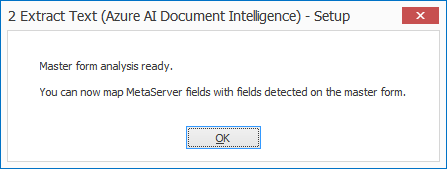
Step 2) You then map the detected field labels and table headers that you are interested in with MetaServer fields.
NOTE: Table headers are pre-fixed with “Line Item” to distinguish them from regular, single value fields.
With your new Master Form, you can now test other forms of the same type to check if all the data is detected.
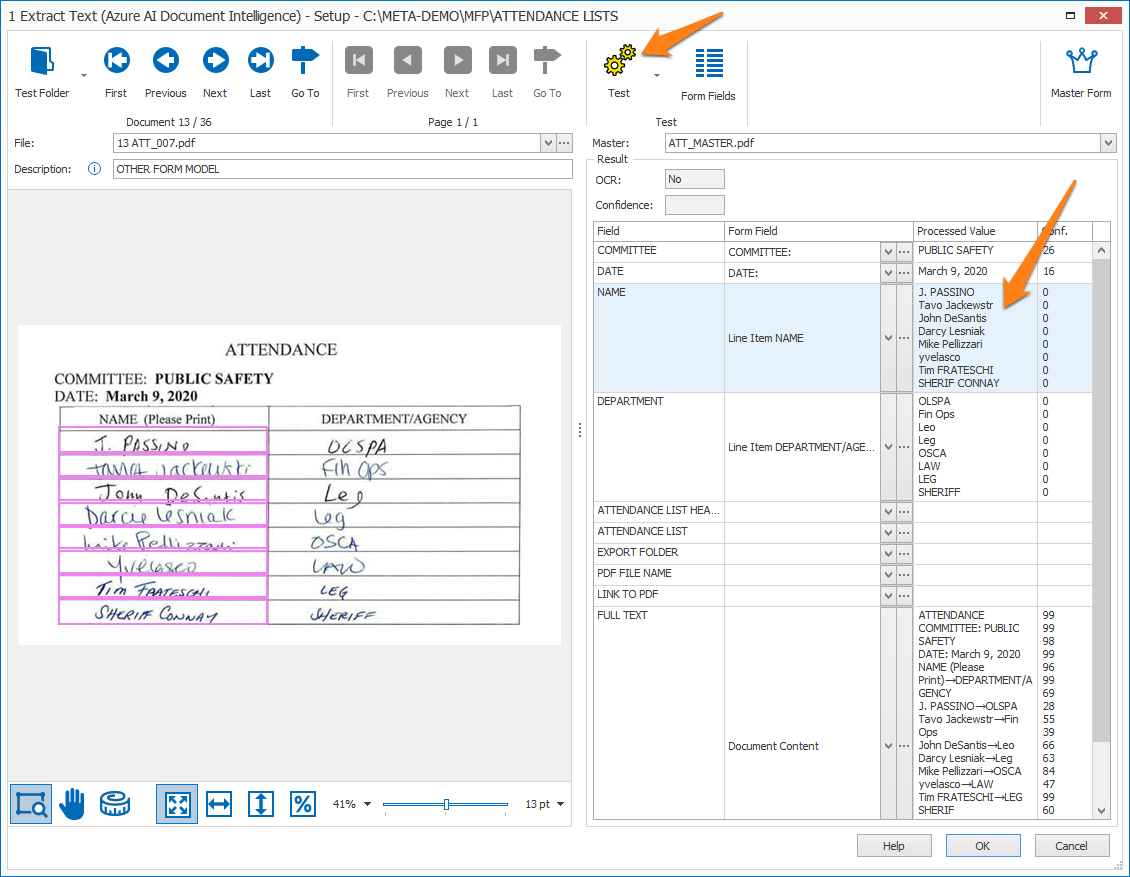
Step 3) If you come across any variations of the same form where different labels are used for the same field, you need to define alternate labels for this field or column.
For example, on the standard sample forms, a column label “NAME” was detected. But on another version of the form, the label is called “NAME (Please Print)”. You can define “NAME (Please Print)” as an alternate label for NAME.
First, press the “Form Fields” button.
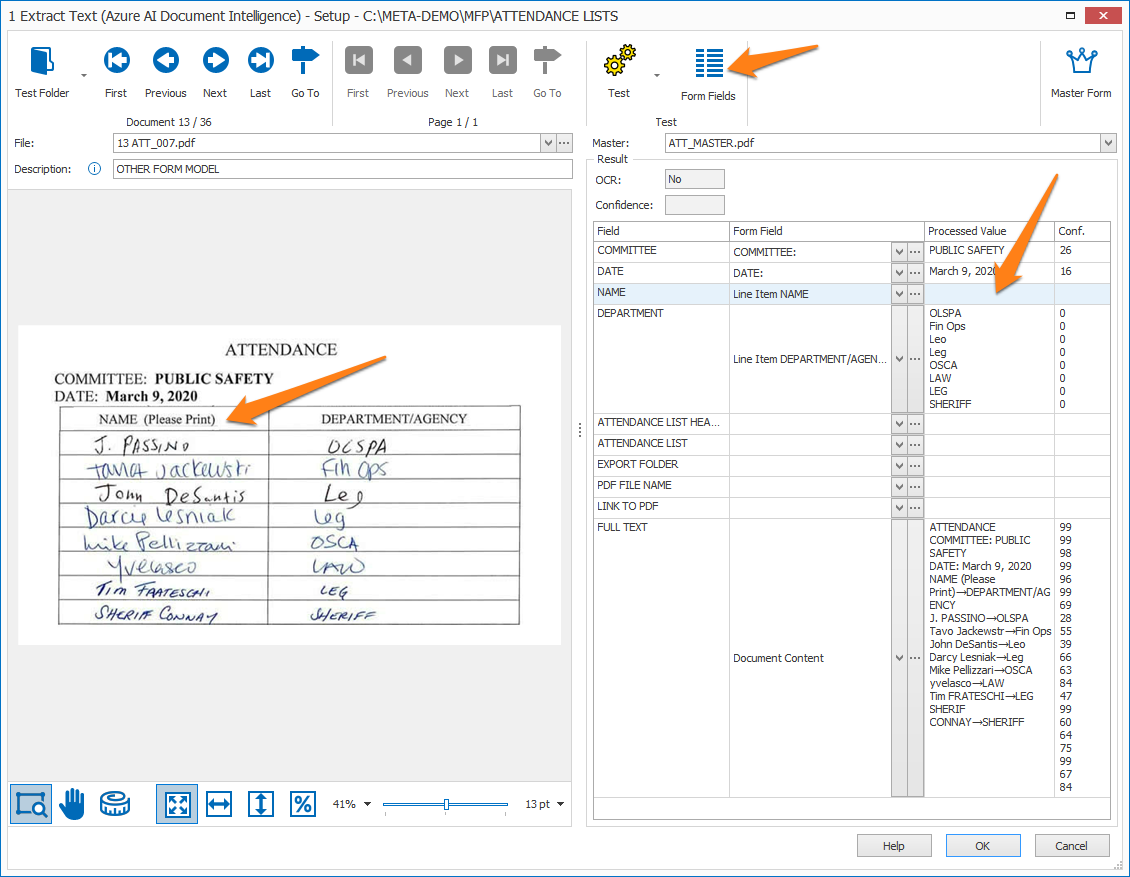
This panel shows all your test form’s labels and values on the left side. The right side shows the Master Form’s labels and values. Select the alternate column label, in this case “Line Item NAME (Please Print)”, on the left side and copy it.
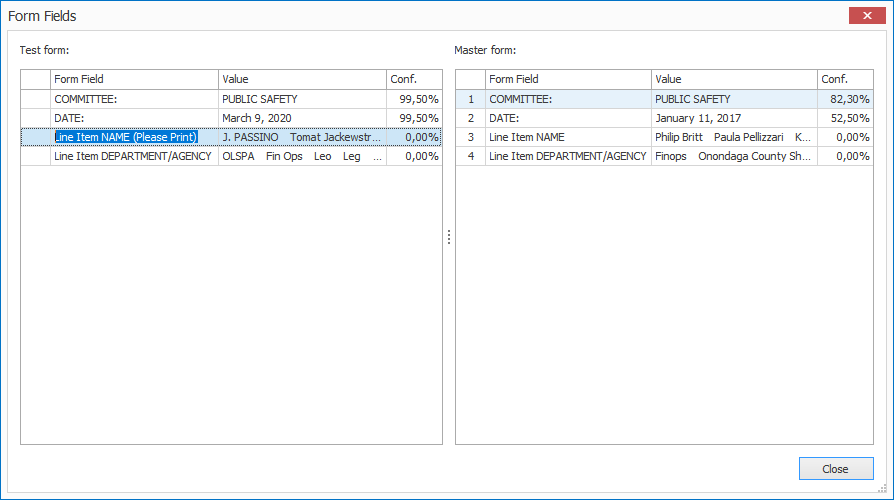
Step 4) To add the alternate field name, press the setup button (…) next to the Form Field name, in this case “Line Item NAME”. Please note that the alternate labels are evaluated in sequence of appearance.
Paste the alternate field name in the list and press OK.
When you test the form now, the alternate label “NAME (Please Print)” is also used to detect the “NAME” column and it is successfully extracted.
The “Receipt” model automatically extracts merchant name, dates, line items, quantities, and totals from printed and handwritten receipts. The version v3.0 also supports single-page hotel receipt processing. The “Receipt” prebuilt model is more limited then the “Invoice” model. In our tests, for European tax receipts we see better results with the invoice model.
This model reads machine printed text, cursive handwriting, barcodes and CMC7 text.
You can find more details regarding pricing in the pricing explanation above.
The preview model is documented here:
Receipt model:
https://learn.microsoft.com/en-us/azure/applied-ai-services/form-recognizer/concept-receipt
The “ID Document” model automatically extracts information from ID cards, passports, driver licenses, residence permits and US social security cards. It can also automatically classify the ID document, which is shown in the “Document Type” field.
You can find more details regarding pricing in the pricing explanation above.
More detailed information about this model can be found here:
https://learn.microsoft.com/en-us/azure/ai-services/document-intelligence/concept-id-document
The “Read” model automatically extracts the full text. This model limits itself to only extracting the full text, but it often returns better results than the Extract Text (Azure AI Vision) rule’s engine.
Since it does not include any special extraction logic like the prebuilt models, it is also a cheaper pricing tier. You can find more details regarding pricing in the pricing explanation above.
This model reads machine printed text, cursive handwriting, barcodes and CMC7 text.
The preview model is documented here:
Read model:
https://learn.microsoft.com/en-us/azure/applied-ai-services/form-recognizer/concept-receipt
With a “Custom Classification” model, you can detect your document type in a single step. You can then also use the result to automatically separate document sets based on the document type.
You build your classification model using the Azure Document Intelligence Studio (DI Studio).
You can find more details regarding pricing in the pricing explanation above.
Creating a new Custom Classification Model
Step 1) In the DI Studio, create a new “Custom classification model”.
Step 2) Create a new project and follow the wizard’s steps.
Step 3) Upload your training samples (minimum 5 samples per document class) and label them. This will assign each of them to a document class (= document type).
Step 4) Once you’re finished, you can go ahead and “Train” your model. Depending on the complexity of your model, it should finish building your model in a few minutes.
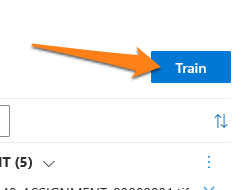
Step 5) As soon as your model’s finished, you can test your classification model on other samples in the “Test” tab.
In case there are any mistakes, you can go back to your “Label data” tab and adjust your labels or add more samples where necessary. You then retrain your model and test again.
Step 6) When you are satisfied with your final classification model, you can select it from the “Model” list in your Extract Text (Azure AI Document Intelligence) rule.
Any future changes that happen to your custom classification model will be automatically applied.
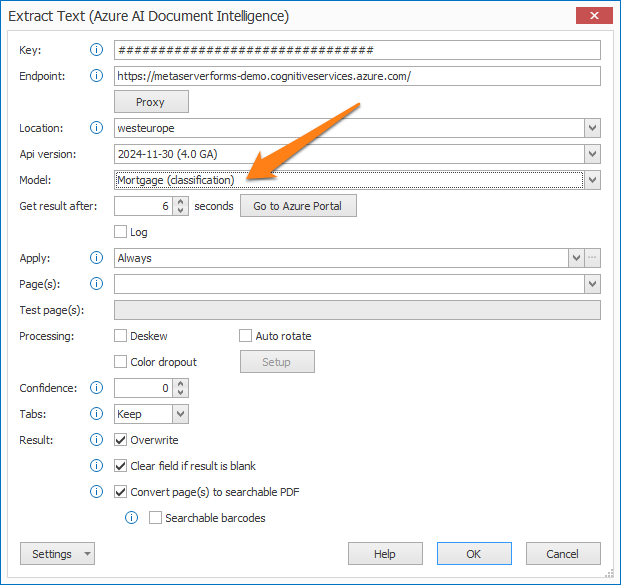
Step 8) Map the Document Type field with the corresponding MetaServer field.
You can also test other samples within the setup to check if the document type was detected correctly.
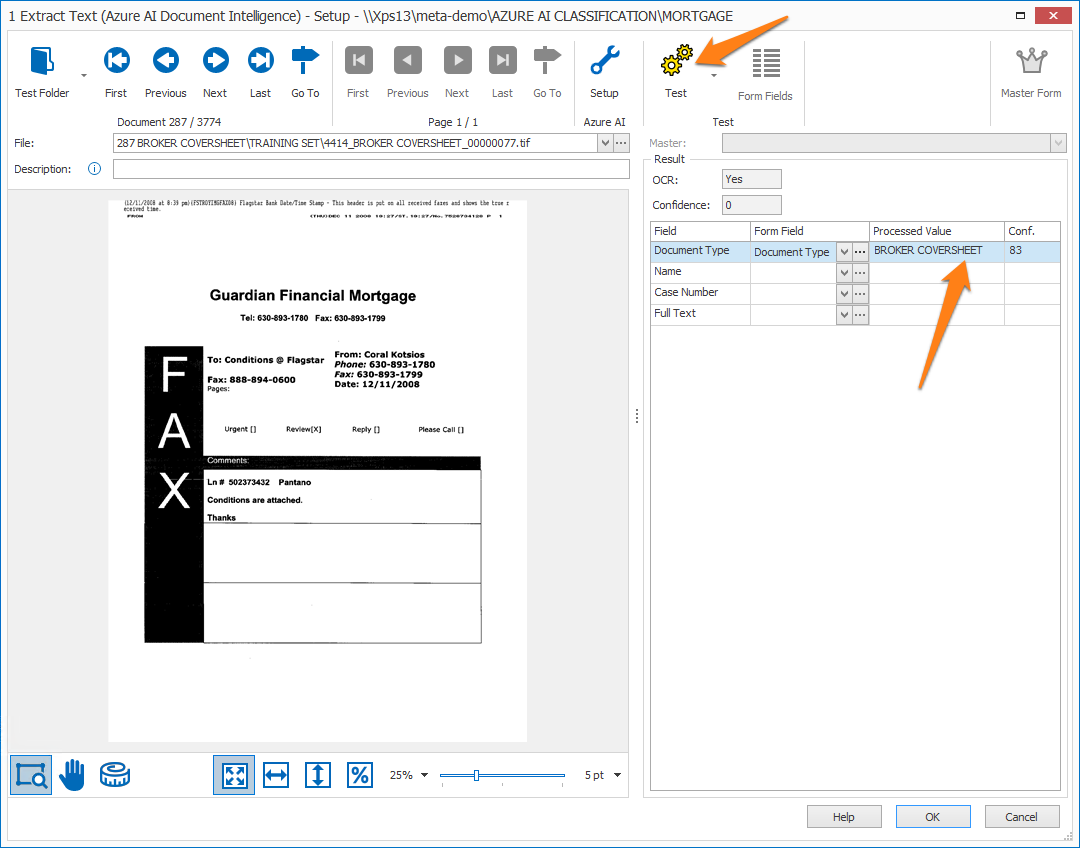
07 – Get result after [x] seconds: by default, this time is set to 6 seconds.
We recommend only changing this to a lower number if you have signed up for Microsoft Azure AI Document Intelligence’s paid plan. Because the Free plan is limited to 1 call every 2 seconds, we recommend to run extraction with a Free Plan on a single core and keep the “Get result after [x] seconds” at 6 seconds.
08 – Log: enable this option to create a log file each time the Microsoft Azure AI Document Intelligence engine is called. This option is typically used during diagnosing issues with Microsoft Azure.
On the client side, you can find the log information after running a Test in Extraction in the following folder:
C:\ProgramData\CaptureBites\Programs\Admin\Data\Log
On the server side, after processing some documents, you can find the log information in the following folder:
C:\ProgramData\CaptureBites\Programs\MetaServer\Data\Log
09 – Apply: choose when to apply the rule. The default option is “Always”, which means that the rule is always applied. Press the drop-down arrow to see all other available conditions.

A good example of conditional extraction, is if you first try to extract a value using the Extract Text rule (= standard OCR engine) or Extract Text (Azure Computer Vision) rule but it doesn’t return a valid result. Only then will you let the Extract Text (Azure AI Document Intelligence) rule try and extract the value.
This speeds up the extraction process and only uses calls to your Microsoft Azure AI Document Intelligence resource when your first search didn’t return a good result.

1) If value of field: press the drop-down arrow to select the field value that needs to be evaluated.
2) is equal to / is not equal to / is greater than /…: enter the other value your field value needs to be compared with. You can also press the drop-down button to select different system and index values to compose your value.

10 – Page: set the page number to where the information is located. The default is set to all pages (= blank).
For example:
– Enter 1 for the 1st page
– Enter -1 for the last page
– Enter 1-3 to extract from page 1 to page 3.
– Leave this empty in case you want to extract all pages (same as 1–1)
– Etc.
You can also press the drop-down arrow to use a field value containing a page number value to switch the page number(s) dynamically.
Example use-case: A form contains 10 pages. You are interested in extracting the information on the page about the “Bank Details” with a big heading “SECTION 5: BANK DETAILS”. The form’s pages are not always in the correct sequence, meaning that the bank details can be on any of the 10 pages. You first use a Find Word with Mask / Words rule to find the words “SECTION 5: BANK DETAILS” and put the found words in a field called, for example, “KEYWORD”. If the keyword is found on page 7, then the variable { Page Number, KEYWORD } would return the value “7”.
You can then use the field “KEYWORD” as your Page in your Extract Text (Azure AI Document Intelligence) rule.
NOTE: if you use a variable as your Page value, you can specify a Test page, solely for testing purposes.
NOTE: If a document does not contain a specific page, it is ignored. For example, extracting page “2,3” on a 2-page document will only extract page 2.
The free F0 plan in combination with the invoice model, will only process a maximum number of 2 pages for each invoice. With the page range you can determine what those pages are. For example 1,-1 would send the first and last page of each invoice.
01 – Deskew & Rotate: if your documents are skewed or rotated incorrectly, you can enable the Deskew and/or Rotate option to optimize Text extraction. It will also result in a corrected version of the page(s).
02 – Color Dropout: if your documents contains a lot of colored tables, lines or stamps throughout the values you want to extract, you can enable the the color dropout feature, which allows you to select up to 3 dropout colors.
Press the setup button to specify which colors to drop out.
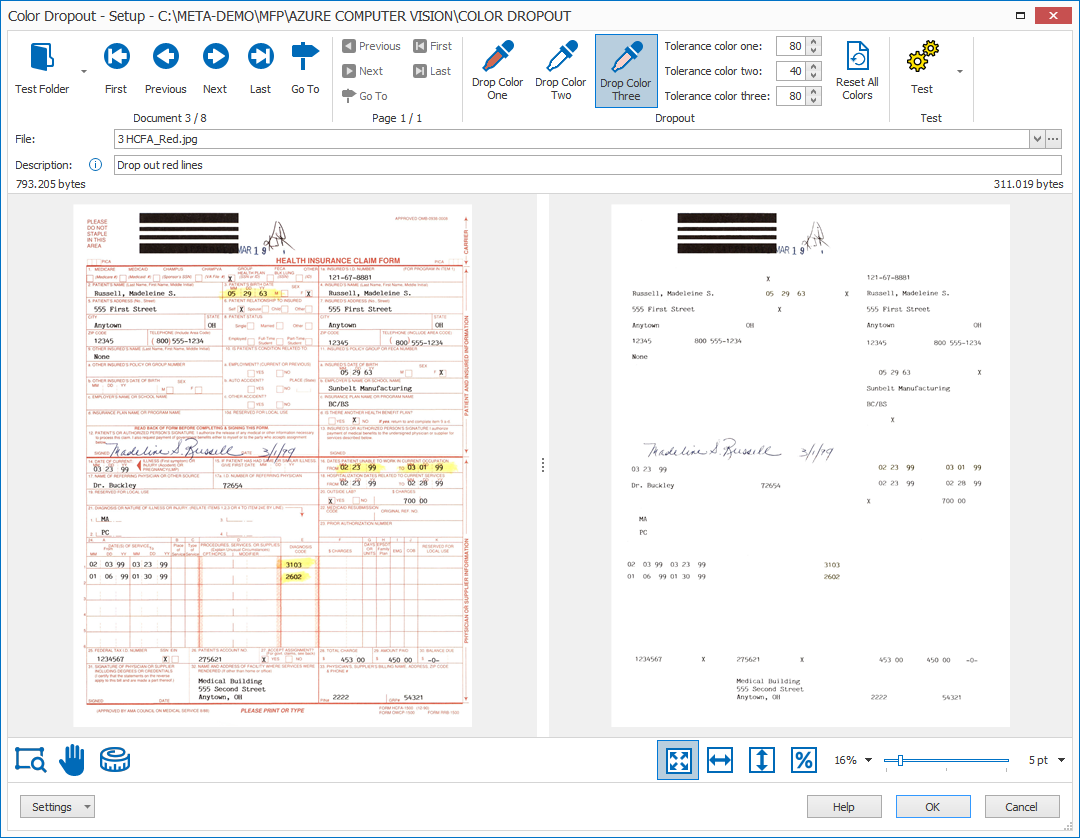
Each selected color has its tolerance. With the Test button, you can see the effect after dropping out the selected colors in the right preview windows.
To reset all dropout colors to white (off), you can use the “Reset All Colors” button.
NOTE: The filtered image is only used temporarily to improve text extraction. The processed image keeps all the original colors.
03 – Confidence: characters with a confidence level lower than the set confidence level, will be ignored and not returned in the result. If set to 0, all characters are accepted.
For legacy reasons, this setting is retained. We recommend to start using the new Check if confidence is lower than option in the validate rules.
To help you in defining the correct confidence level, you can check the confidence level of each field in the “Confidence” column of your test results.
NOTE: The “Confidence” value shown beneath “OCR” refers to the confidence level of the Azure AI Document Intelligence’s “Document Content” field value, which is currently mapped to the “Full Text” value in our example.
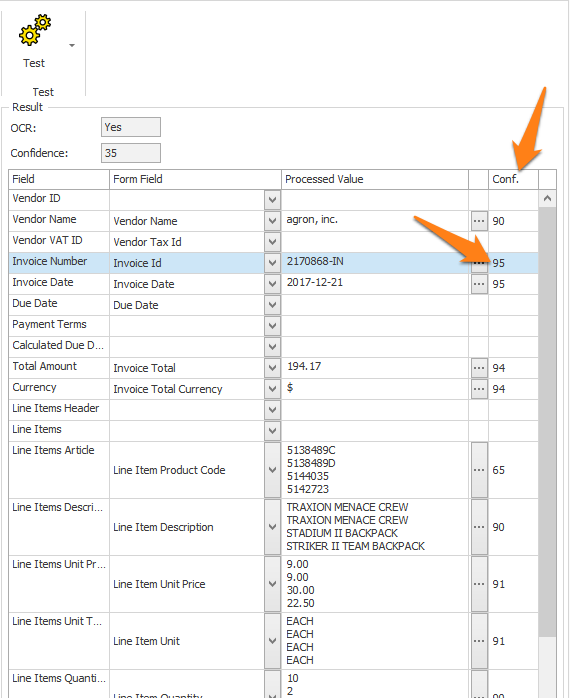
04 – Tabs: by default, lines are segmented in multiple word groups that are separated by tabs. If you want no tabs at all, press the drop-down button to select the “Remove” option and all the words will be grouped as 1 single word group for each line.

As a result, you will be able to search handwritten, arabic, cyrillic or low-quality text in your exported PDF:
This high-quality text layer can also be used during Validation with the Select text tool. To do this, please make sure you also enable the “Use searchable text layer if present” option in the Select text tool setup:
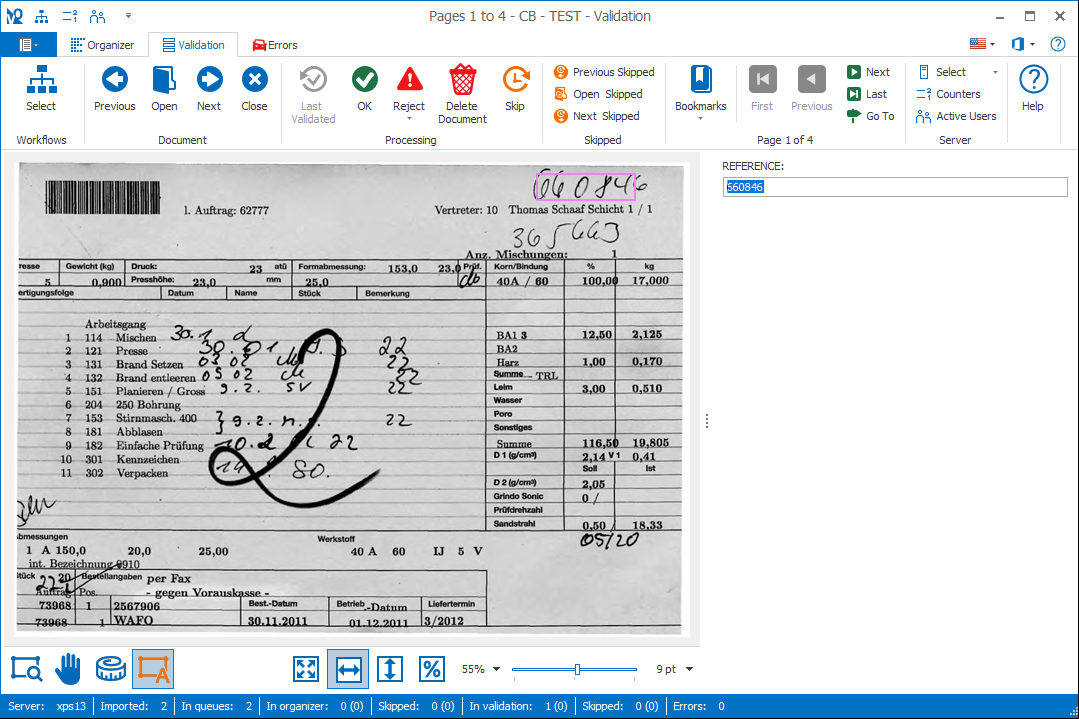
06 – Searchable barcodes: enable this option when you also want to be able to search for barcode values when you convert page(s) to searchable PDF.
01 – Field: The “Field” column shows your MetaServer fields. You can map them to the corresponding AI Document Intelligence field values using the drop-down arrow in the “Form Field” column (see below).
02 – Form Field: based on the selected Azure AI Document Intelligence Model (Invoice, Receipt, Other Form, Read), you can map your MetaServer fields to the model’s extracted field values.
NOTE: As you will see in the output, some field values, like dates and amounts, are automatically reformatted by the Azure AI Document Intelligence engine. This is to output consistent, standardized formats, regardless of the input.
Dates are formatted to YYYY-MM-DD format.
For example:
12/06/2023
becomes:
2023-06-12 (on a European invoice)
2023-12-06 (on a US invoice)
Amounts are formatted without thousand separators, they have a period (.) as a decimal character and the number of digits after decimal will be up to the available number of digits, except for the Total amounts of the header data where it will round it to 2 digits.
For general amounts:
*.00 will become *.0
*.0000 wil become *.0
*.20 will become *.2
*.1254 will remain *.1254
For Total amounts of header data:
*.00 will become *.0
*.0000 wil become *.00
*.20 will become *.2
*.1254 will become *.13
The currency is also removed from all types of amounts.
For example:
£20,432.625
becomes:
20432.2
Time values are formatted to a HH:mm:ss format.
For example:
07:45 PM
becomes:
19:45:00
If the format needs to be different for your output, you can change it for each field by using the Extract action’s Format and Edit rules.
All models (= prebuilt and Read models) can return the following form field values:
| Name | Type | Description | Example Processed Value |
|---|---|---|---|
| Document Content | string |
The complete extracted text, including printed and handwritten text, and barcode values (if present), without any formatting. This can be useful if you want to extract any other values that the model was not able to find. You would typically map it to your “Full Text” field which you can then use as a source in your Extract rules. |
AB/7R BV 1540030393597 1540030393597 INVOICE CONTOSO LTD. Contoso Headquarters→INVOICE: INV-100 123 456th St→INVOICE DATE: 11/15/2019 New York, NY, 10001→DUE DATE: 12/15/2019 CUSTOMER NAME: MICROSOFT CORPORATION Signed off on 18/06/18 (…) |
| Document Content Printed | string | Only returns printed text from your document. If there is handwritten text present, it will filter this out of the result. | 1540030393597 INVOICE CONTOSO LTD. Contoso Headquarters→INVOICE: INV-100 123 456th St→INVOICE DATE: 11/15/2019 New York, NY, 10001→DUE DATE: 12/15/2019 CUSTOMER NAME: MICROSOFT CORPORATION (…) |
| Document Content Handwritten | string | Only returns handwritten text from your document. If there is printed text present, it will filter this out of the result. | AB/7R BV Signed off on 18/06/18 |
| Document Content Printed and Handwritten | string |
The complete extracted text, filtering out any barcodes (if present), without any formatting. This can be useful if you want to extract any other values that the model was not able to find. You would typically map it to your “Full Text” field which you can then use as a source in your Extract rules. |
AB/7R BV 1540030393597 INVOICE CONTOSO LTD. Contoso Headquarters→INVOICE: INV-100 123 456th St→INVOICE DATE: 11/15/2019 New York, NY, 10001→DUE DATE: 12/15/2019 CUSTOMER NAME: MICROSOFT CORPORATION Signed off on 18/06/18 (…) |
| Dominant Language | string | Returns the iso code of the document’s dominant language. | en |
| Barcodes (All / Type) | string |
Returns all barcode values on the document OR the values of the specified barcode type. Currently, the engine supports the following barcode types: – Codabar |
1540030393597 |
The Invoice model can return the following form field values:
Single Value Fields (see example invoice on the right):
| Name | Type | Description | Standardized Output Format | Example Processed Value |
|---|---|---|---|---|
| Customer Name | String | Invoiced customer | MICROSOFT CORPORATION | |
| Customer Id | String | Customer reference ID | CID-12345 | |
| Purchase Order | String | Purchase order reference number | PO-3333 | |
| Invoice Id | String | ID for this specific invoice (often “Invoice Number”) | INV-100 | |
| Invoice Date | Date | Date the invoice was issued | YYYY-MM-DD | 2019-11-15 |
| Due Date | Date | Date payment for this invoice is due | YYYY-MM-DD | 2019-12-15 |
| Vendor Name | String | Vendor name | CONTOSO LTD. | |
| Vendor Tax Id | String | The taxpayer number associated with the vendor | ||
| Vendor Address | String | Vendor mailing address | 123 456th St New York, NY, 10001 | |
| Vendor Address Recipient | String | Name associated with the Vendor Address | Contoso Headquarters | |
| Customer Address | String | Mailing address for the Customer | 123 Other St, Redmond WA, 98052 | |
| Customer Tax Id | String | The taxpayer number associated with the customer | ||
| Customer Address Recipient | String | Name associated with the Customer Address | Microsoft Corp | |
| Billing Address | String | Explicit billing address for the customer | 123 Bill St, Redmond WA, 98052 | |
| Billing Address Recipient | String | Name associated with the BillingAddress | Microsoft Finance | |
| Shipping Address | String | Explicit shipping address for the customer | 123 Ship St, Redmond WA, 98052 | |
| Shipping Address Recipient | String | Name associated with the ShippingAddress | Microsoft Delivery | |
| Payment Term | String | The terms of payment for the invoice | 30 NET | |
| Subtotal | Number | Subtotal field identified on this invoice | Integer | 100.0 |
| Subtotal Currency Code | String | The currency code associated with the extracted subtotal amount | USD | |
| Subtotal Currency Symbol | String | The currency symbol associated with the extracted subtotal amount | $ | |
| Total Tax | Number | Total tax field identified on this invoice | Integer | 10.0 |
| Total Tax Currency Code | String | The currency code associated with the extracted invoice total amount | USD | |
| Total Tax Currency Symbol | String | The currency symbol associated with the extracted invoice total amount | $ | |
| Invoice Total | Number (USD) | Total new charges associated with this invoice | Integer | 110.0 |
| Invoice Total Currency Code | String | The currency code associated with the extracted invoice total amount | USD | |
| Invoice Total Currency Symbol | String | The currency symbol associated with the extracted invoice total amount | $ | |
| Amount Due | Number (USD) | Total Amount Due to the vendor | Integer | 610.0 |
| Amount Due Currency Code | String | The currency code associated with the extracted invoice total amount | USD | |
| Amount Due Currency Symbol | String | The currency symbol associated with the extracted invoice total amount | $ | |
| Service Address | String | Explicit service address or property address for the customer | 123 Service St, Redmond WA, 98052 | |
| Service Address Recipient | String | Name associated with the Service Address | Microsoft Services | |
| Remittance Address | String | Explicit remittance or payment address for the customer | 123 Remit St New York, NY, 10001 | |
| Remittance Address Recipient | String | Name associated with the Remittance Address | Contoso Billing | |
| Service Start Date | Date | First date for the service period (for example, a utility bill service period) | YYYY-MM-DD | 2019-10-14 |
| Service End Date | Date | End date for the service period (for example, a utility bill service period) | YYYY-MM-DD | 2019-11-14 |
| Previous Unpaid Balance | Number | Explicit previously unpaid balance | Integer | 500.0 |
| Previous Unpaid Balance Currency Code | String | The currency code associated with the extracted invoice total amount | USD | |
| Previous Unpaid Balance Currency Symbol | String | The currency symbol associated with the extracted invoice total amount | $ | |
| Payment Details IBAN | String | Holds the IBAN Payment Option details | ||
| Payment Details SWIFT | String | Holds the SWIFT Payment Option details | ||
| Total Discount | Number | The total discount applied to an invoice | Integer | |
| Total Discount Currency Code | String | The currency code associated with the extracted invoice total amount | USD | |
| Total Discount Balance Currency Symbol | String | The currency symbol associated with the extracted invoice total amount | $ |
Line items (see example invoice on the right):
| Name | Type | Description | Example Text | Example Processed Value |
|---|---|---|---|---|
| Line Item Amount | Number | The amount of the line item | $60.00 $30.00 $10.00 |
60.0 30.0 10.0 |
| Line Item Currency Code | String | The currency code associated with the extracted line item amount | USD USD USD |
|
| Line Item Currency Symbol | String | The currency symbol associated with the extracted line item amount | $ $ $ |
|
| Line Item Description | String | The text description for the invoice line item | Consulting Services Document Fee Printing Fee |
Consulting Services Document Fee Printing Fee |
| Line Item Quantity | Number | The quantity for this invoice line item | 2 3 10 |
2 3 10 |
| Line Item Unit | String | The unit of the line item, e.g, kg, lb etc. |
hours pages |
hours pages |
| Line Item Unit Price | Number | The net or gross price (depending on the gross invoice setting of the invoice) of one unit of this item | $30.00 $10.00 $1.00 |
30.0 10.0 1.0 |
| Line Item Unit Price Currency Code | String | The currency code associated with the extracted line item unit price | USD USD USD |
|
| Line Item Unit Price Currency Symbol | String | The currency symbol associated with the extracted line item unit price | $ $ $ |
|
| Line Item Product Code | String | Product code, product number, or SKU associated with the specific line item | A123 B456 C789 |
A123 B456 C789 |
| Line Item Date | Date | Date corresponding to each line item. Often it’s a date the line item was shipped | 3/4/2021 3/5/2021 2/6/2021 |
2021-04-03 2021-05-03 2021-06-03 |
| Line Item Tax | Number | Tax associated with each line item. Possible values include tax amount and tax Y/N | ||
| Line Item Tax Rate | Number | Tax Rate associated with each line item. | 10% 5% 20% |
10% 5% 20% |
The Receipt model can return the following form field values:
Thermal receipts (General, Meal, Credit Card, Gas, Parking):
| Field | Type | Description | Example Value |
Example Processed Value |
| Merchant Name | string | Name of the merchant issuing the receipt | Contoso | Contoso |
| Merchant Phone Number | phoneNumber | Listed phone number of merchant | 987-654-3210 | 987-654-3210 |
| Merchant Address | address | Listed address of merchant | 123 Main St. Redmond WA 98052 | 123 Main St. Redmond WA 98052 |
| Total | number | Full transaction total of receipt | $14.34 | 14.34 |
| Transaction Date | date | Date the receipt was issued | June 06, 2019 | 2019-06-06 |
| Transaction Time | time | Time the receipt was issued | 4:49 PM | 16:49:00 |
| Subtotal | number | Subtotal of receipt, often before taxes are applied | $12.34 | 12.34 |
| Total Tax | number | Tax on receipt, often sales tax or equivalent | $2.00 | 2.0 |
| Tip | number | Tip included by buyer | $1.00 | 1.0 |
| Line Item Total Price | number | Total price of line item | 7.20 € 7.80 € 26.50 € 23.90 € |
7.2 7.8 26.5 23.9 |
| Line Item Description | string | Item description | Surface Pro 6 Wireless Mouse Model 2 |
Surface Pro 6 Wireless Mouse Model 2 |
| Line Item Quantity | number | Quantity of each item | 1 2 1 1 |
1 2 1 1 |
| Line Item Price | number | Individual price of each item unit | $1.00 $0.56 $3.99 |
1.0 0.56 3.99 |
Hotel receipts:
| Field | Type | Description | Example Value |
Example Processed Value |
| Merchant Name | string | Name of the merchant issuing the receipt | Contoso | Contoso |
| Merchant Phone Number | phoneNumber | Listed phone number of merchant | 987-654-3210 | 987-654-3210 |
| Merchant Address | address | Listed address of merchant | 123 Main St. Redmond WA 98052 | 123 Main St. Redmond WA 98052 |
| Total | number | Full transaction total of receipt | $14.34 | 14.34 |
| Arrival Date | date | Date of arrival | 27Mar21 | 2021-03-21 |
| Departure Date | date | Date of departure | 28Mar21 | 2021-03-28 |
| Currency | string | Currency unit of receipt amounts (ISO 4217), or ‘MIXED’ if multiple values are found | USD EUR |
MIXED |
| Merchant Aliases | string | Alternative name of merchant | Contoso (R) | Contoso |
| Line Item Total Price | number | Total price of line item | 7.20 € 7.80 € 26.50 € 23.90 € |
7.2 7.8 26.5 23.9 |
| Line Item Date | date | Item date | 27Mar21 | 2021-03-27 |
| Line Item Description | string | Item description | Room Charge BBQ Hamburger Salted Almonds |
Room Charge BBQ Hamburger Salted Almonds |
| Line Item Category | string | Item category | Room Room Service Mini Bar |
Room Room Service Mini Bar |
The form field values for the Other Form model vary depending on the form. Please refer to the setup instructions for more details.
The ID Document model can return the following form field values:
| Name | Type | Description | Example Processed Value |
|---|---|---|---|
| Document Type | string | The type of ID document. |
|
National Identity Card:
| Field | Type | Description | Example Value |
Example Processed Value |
| Country Region | Country Region | Country or region code | USA | USA |
| Region | string | State or province | Washington | Washington |
| Document Number | string | National identity card number | WDLABCD456DG | WDLABCD456DG |
| Document Discriminator | string | National identity card document discriminator | 12645646464554646456464544 | 12645646464554646456464544 |
| First Name | string | Given name and middle initial, if applicable | LIAM R. | LIAM R. |
| Last Name | string | Surname | TALBOT | TALBOT |
| Address | address | Address | 123 STREET ADDRESS YOUR CITY WA 99999-1234 | 123 STREET ADDRESS YOUR CITY WA 99999-1234 |
| Date of Birth | date | Date of birth | 01/06/1958 | 01/06/1958 |
| Date of Expiration | date | Date of expiration | 08/12/2020 | 2020-12-08 |
| Date of Issue | date | Date of issue | 08/12/2012 | 2012-12-08 |
| Eye Color | string | Eye color | BLU | BLU |
| Hair Color | string | Hair color | BRO | BRO |
| Height | string | Height | 5’11” | 5’11” |
| Weight | string | Weight | 185LB | 185LB |
| Sex | string | Sex | M | M |
Passport:
| Field | Type | Description | Example Value |
Example Processed Value |
| Document Number | string | National identity card number | WDLABCD456DG | WDLABCD456DG |
| First Name | string | Given name and middle initial, if applicable | JENNIFER | JENNIFER |
| Middle Name | string | Name between given name and surname | REYES | REYES |
| Last Name | string | Surname | BROOKS | BROOKS |
| Aliases | string | Also known as | MAY LIN | MAY LIN |
| Date of Birth | date | Date of birth | 1980-01-01 | 1980-01-01 |
| Date of Expiration | date | Date of expiration | 2019-05-05 | 2019-05-05 |
| Date of Issue | date | Date of issue | 2014-05-06 | 2014-05-06 |
| Sex | string | Sex | M | M |
| Country Region | country region | Issueing country or organization | USA | USA |
| Nationality | county region | Nationality | USA | USA |
| Place of Birth | string | Place of birth | MASSACHUSETTS, U.S.A. | MASSACHUSETTS, U.S.A. |
| Place of Issue | string | Place of issue | LA PAZ | LA PAZ |
| Issueing Authority | string | Issueing authority | United States Department of State | United States Department of State |
| Personal Number | string | Personal ID Number | A234567893 | A234567893 |
| Machine Readable Zone | string | The complete value of the machine readable zone at the bottom of a passport. It holds all the passport’s ID information. |
P<USABROOKS<<JENNIFER |
P<USABROOKS<<JENNIFER <<<<<<<<<<<<<<<<<<<<<< <3400200135USA8001014 F1905054710000307<715816 |
| Machine Readable Zone Country Region | string | Country region derived from the Machine Readable Zone | USA | USA |
| Machine Readable Zone Date of Birth | date | Date of birth derived from the Machine Readable Zone | 800101 | 1980-01-01 |
| Machine Readable Zone Date of Expiration | date | Date of expiration derived from the Machine Readable Zone | 190505 | 2019-05-05 |
| Machine Readable Zone Document Number | string | National identity card number derived from the Machine Readable Zone | 340020013 | 340020013 |
| Machine Readable Zone First Name | string | First name derived from the Machine Readable Zone | JENNIFER | JENNIFER |
| Machine Readable Zone Last Name | string | Surname derived from the Machine Readable Zone | BROOKS | BROOKS |
| Machine Readable Zone Nationality | country region | Nationality derived from the Machine Readable Zone | USA | USA |
| Machine Readable Zone Sex | string | Sex derived from the Machine Readable Zone | F | F |
Residence Permit:
| Field | Type | Description | Example Value |
Example Processed Value |
| Country Region | Country Region | Country or region code | USA | USA |
| Document Number | string | National identity card number | WDLABCD456DG | WDLABCD456DG |
| First Name | string | Given name and middle initial, if applicable | LIAM R. | LIAM R. |
| Last Name | string | Surname | TALBOT | TALBOT |
| Date of Birth | date | Date of birth | 01/06/1958 | 1958-06-01 |
| Date of Expiration | date | Date of expiration | 08/12/2020 | 2020-12-08 |
| Date of Issue | date | Date of issue | 08/12/2012 | 2012-12-08 |
| Sex | string | Sex | M | M |
| Place of Birth | string | Place of birth | Germany | Germany |
| Category | string | Permit category | DV2 | DV2 |
| Address | address | Address | 123 STREET ADDRESS YOUR CITY WA 99999-1234 | 123 STREET ADDRESS YOUR CITY WA 99999-1234 |
US Social Security Card:
| Field | Type | Description | Example Value |
Example Processed Value |
| Document Number | string | National identity card number | WDLABCD456DG | WDLABCD456DG |
| First Name | string | Given name and middle initial, if applicable | LIAM R. | LIAM R. |
| Last Name | string | Surname | TALBOT | TALBOT |
| Date of Issue | date | Date of issue | 08/12/2012 | 2012-12-08 |
The Custom Classification model can return the following form field values:
| Name | Type | Description |
|---|---|---|
| Document Type | string | The type of document. The value depends on how you have trained your classification model. Please refer to the setup instructions for more details. |
01 – Test button / Auto Test Mode: press the Test button to show the extracted values of your invoice in the Result window and get additional information about the result such as if OCR was applied or not, the confidence level of each field in the “Confidence” column, and the confidence level of the Azure Forms Recognizer’s “Document Content” field value, above the result table.
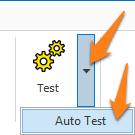
02 – OCR (Yes/No): there are many types of PDFs. The most common PDF type used with MetaServer are Text-Based PDFs and Image-based PDFs.
Electronic / Text-based PDFs are generated by a computer program like MS Word, Invoice / Report creation software, etc. Text-based PDFs already contain computer text represented by fonts. This text can directly be extracted without any OCR processing.
Scanned / Image-based PDFs contain an image of each of the pages of the document and require OCR (Optical Character Recognition) to convert the images to computer text.
The Azure AI Document Intelligence automatically switches between electronic text extraction, in case of text-based PDFs, and OCR extraction, in case of a scanned image.
This way, your Microsoft Azure AI Document Intelligence resource returns a result with 100% confidence with electronic text.
If OCR is applied, the OCR value will indicate Yes.
If the PDF is 100% electronic, then the OCR value will indicate No.
If the PDF is partially electronic but also contains some image information (like logos), then the OCR value will indicate Mixed.
The below example shows a 100% electronic document, as indicated with “No” OCR.
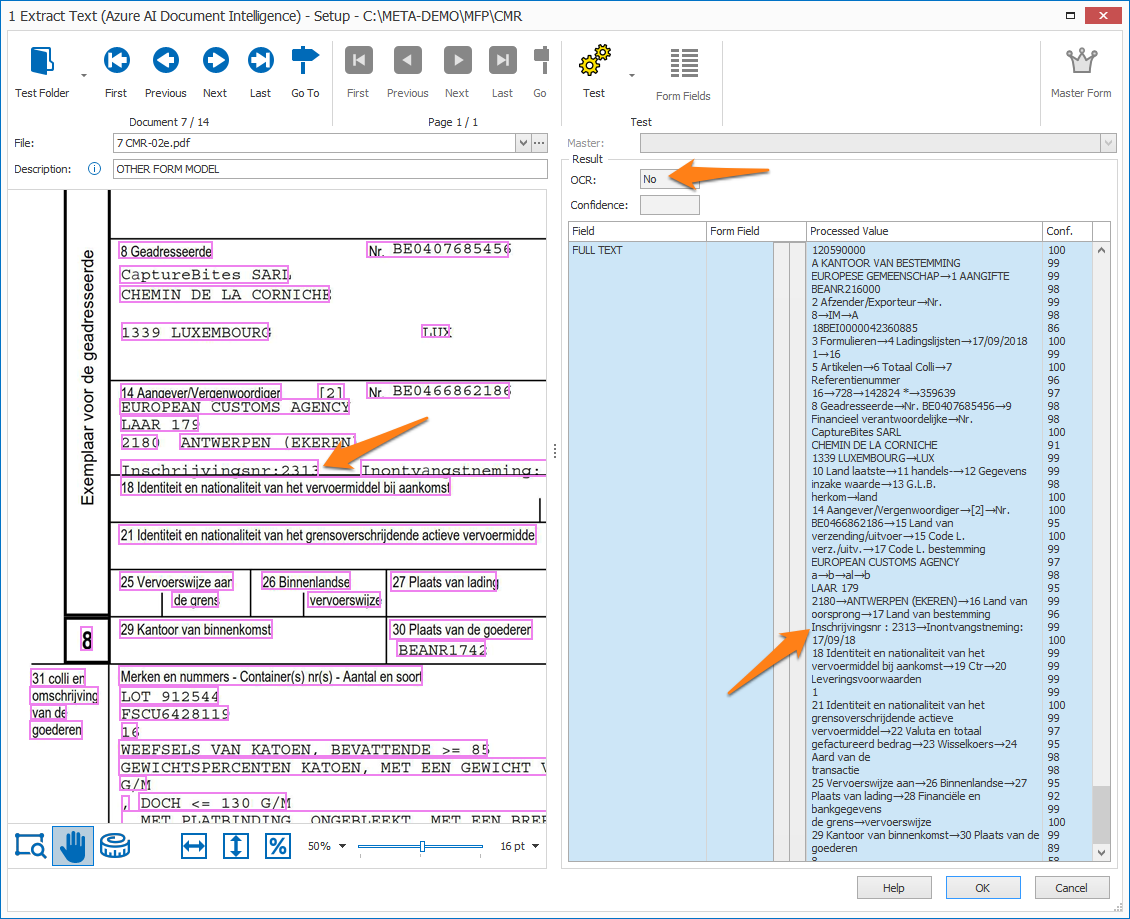
03 – Confidence: this signifies the confidence level of the Azure AI Document Intelligence’s “Document Content” field value, which is currently mapped to the “Full Text” value in our example.
NOTE: The confidence level of each individual field can be found in the “Confidence” column of your test results.
TIP: you can copy the current settings and paste them in another setup window of the same type. Do this by pressing the Settings button in the bottom left of the Setup window and by selecting Copy. Then open another setup window of the same type and select Paste.
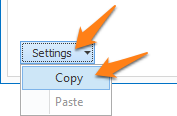
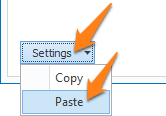

You are also able to run the Azure AI Document Intelligence engine on-premise using Containers through the Docker engine.
Running the engine on-premise can be useful for security and data governance requirements.
You can find a detailed guide discussing the prerequisites and how to set up your AZDI container here.

